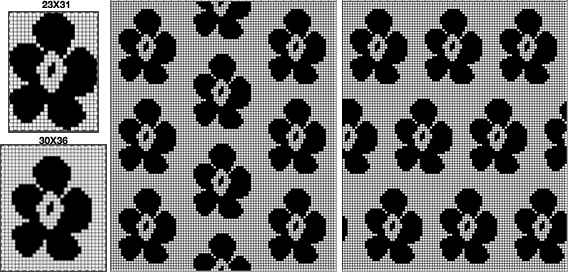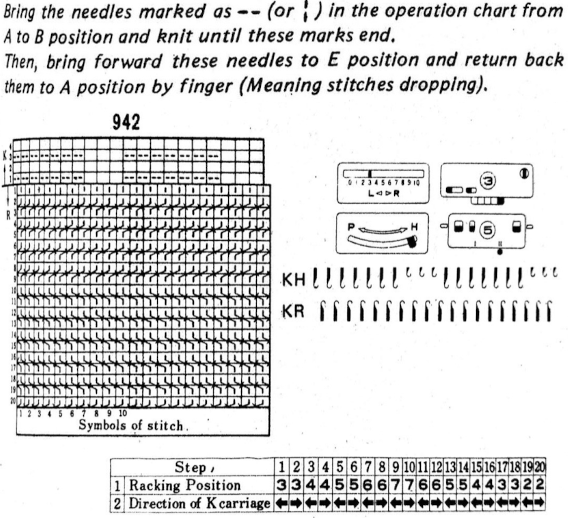Each row of double jacquard consists of at least 2 rows of patterning, one with ground yarn, the other with contrast.
The total number of rows knit to complete each design row and repeat vary with the number of colors used in each row of the design.
The appearance of the knit patterns in front and back faces vary based on the settings used ie, tuck, slip, or normal knit, and their consistency or combinations of in the same piece.
Punchcard knitters are not excluded from producing such fabrics, but the color separation is done manually or using software, marking matching squares to pixels or colored cells on the cards before punching.
Early on pads of graph paper appropriately sized for drawing onto punchcards or mylar sheets followed by tracing were easily available for developing motifs.
The size of the repeat is less important in creating interesting knits than the choice of yarns, colors, and technique choices.
In early art-to-wear days, pre-electronic home knitting machines, large, nonrepetitive images were created by breaking down the full size images into several vertical panels the width of the punchcard repeat plus seaming allowance. The cards could be joined sequentially to an endless number of rows of design height.
Upon completion, the panels were joined side by side to create the final image. The work of Nicki Hitz Edson illustrates some finished items using the method.
Ribber settings for DBJ apply across models in principle and may need adjustment or even a different carriage than the one supplied with the ribber purchase depending on the model, age, and brand of the machine.
If working on a bulky machine, consider using the ladder-back method.
The common method for the color separation suggested in instruction manuals for Japanese knitting machines for two colors per row DBJ is used in these samples.
The repeats for punchcards have a maximum width 24 stitches. Factors of 24 ie 2, 4, 6, 8 also apply.
Each group in the total 24 stitches in each design row is repeated in fixed locations across the needle bed.
Shifting the complete design position in the body of the knit involves moving the needles in work to a different portion of the knit bed.
Before electronic models appeared on the market, old manuals and pubs offered the basis for the share below, the same work may now be accomplished using present software within a few minutes and several clicks of a mouse.
The results can be printed to scale so as to make them traceable onto a blank card with both placed over a true or an improvised lightbox.
A charted view of an initial design:
 One design row of pattern requires 2 rows of punched holes in the in the card, each representing two carriage passes from and back to the color changer.
One design row of pattern requires 2 rows of punched holes in the in the card, each representing two carriage passes from and back to the color changer.
The step-by-step separation for the design on the left repeated across the 24-stitch card width follows.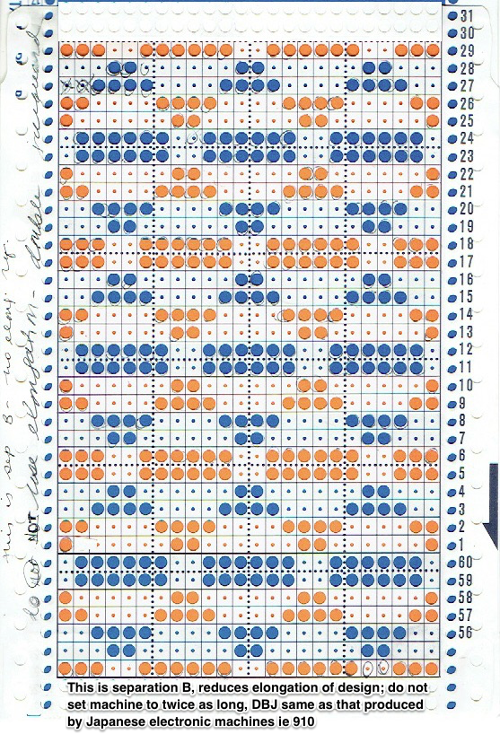 Helpful tools: on one blank card color each section of the card, representing color change sequences. This may be used later to check color separation.
Helpful tools: on one blank card color each section of the card, representing color change sequences. This may be used later to check color separation.
Box the edge numbers in pairs, beginning with numbers 56 and 57, skip two rows to numbers 60 and the factory-marked row 1, the first visual row when the card is in the reader, and so on. as seen on the right.
This separation splits the first and second row of color 1 between the first and last row on the punchcard.
 On a second blank card, prepare a master.
On a second blank card, prepare a master.
The first row is left blank, then 2 rows are punched out, followed by 2 rows left blank, repeat, ending with a blank row. Again working upward, number each row you have punched out on the left-hand side starting with number 54, then 55-56, 57-58, etc, ending with a single row, 23. This will result in number markings matching both sides at the bottom of the card, below the #1 factory mark.
My own master began on the left with the # 53. I also added corresponding design row numbers for each row on the far left. (1 and 2, 3 and 4, and so on). Written notes on right: an even number of rows need to be knit in each color, so in this method, the pattern must be an even number of rows in height, boxed numbers represent rows knit in ground color.
 1: In this method, each color in each design row knits only once, reducing the elongation of the height to width aspect ratio in the knit.
1: In this method, each color in each design row knits only once, reducing the elongation of the height to width aspect ratio in the knit.
The initial design is rendered in color, twice as tall.
A minimum of 36 rows are required for the card to advance properly in the reader.
Take a blank card to be marked with 2 colors, and put the master card on top, fastening the 2 cards together with snaps.
You can now mark holes to be punched with a dark third color.
Copy the first 2 rows of color 2 on rows marked 54 and 55 (or 53 and 54 in my case), and repeat in pairs for the required height.
I like to mark the card to be punched with colored pencils that differ sharply for each color. They have the benefit of being erasable and can help with keeping each row distinct when punching.
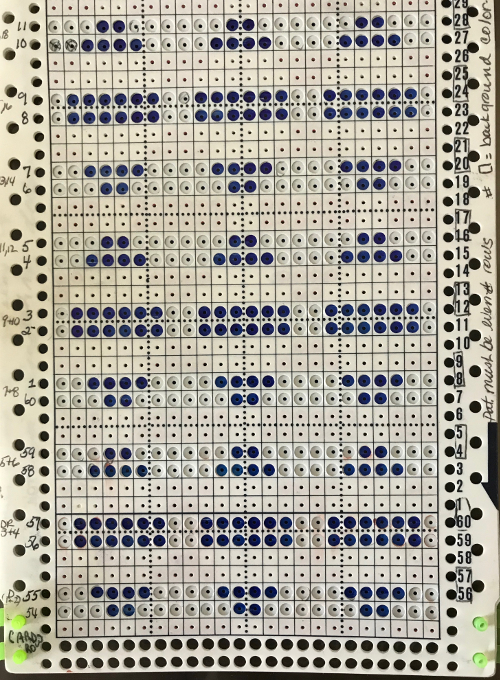 When the completed repeat is marked, unfasten the snaps and move the card down by one row. You will now see the marks you have made through the top row of each set on the master card. Mark through each lower row any blank squares in the row above.
When the completed repeat is marked, unfasten the snaps and move the card down by one row. You will now see the marks you have made through the top row of each set on the master card. Mark through each lower row any blank squares in the row above.
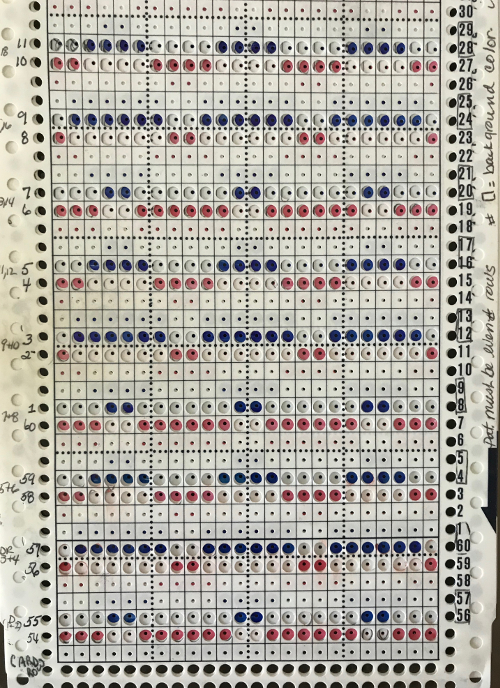 Again, after completing the repeat unfasten the snaps and slide the master up by 2 rows. The card will now be back to its original position, and up by one row. Now you will see the marks you have made on the blank card showing through the bottom of each row of the master card. Mark through each upper row on any square opposite the ones marked in the row below.
Again, after completing the repeat unfasten the snaps and slide the master up by 2 rows. The card will now be back to its original position, and up by one row. Now you will see the marks you have made on the blank card showing through the bottom of each row of the master card. Mark through each upper row on any square opposite the ones marked in the row below. 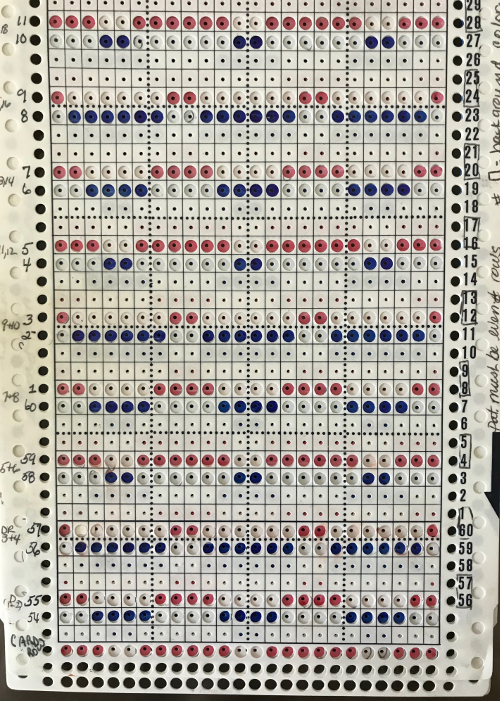 After the repeat is completed, make certain to punch across 2 final rows for the card to create the overlaps for a continuous pattern, as with any other stitch type. Punch out all marks, and you are ready to knit. To check your design visually lay the finished card over the colored master, and correct any errors if noted. Your card is now ready to knit DBJ.
After the repeat is completed, make certain to punch across 2 final rows for the card to create the overlaps for a continuous pattern, as with any other stitch type. Punch out all marks, and you are ready to knit. To check your design visually lay the finished card over the colored master, and correct any errors if noted. Your card is now ready to knit DBJ.
The first preselection row is from left to right with color 1, which will knit in pattern from right to left, moving toward the color changer where colors are changed every 2 rows. This color separation will not work for fabrics that require the same needle selections repeating for pairs of rows throughout.
2: A second master that may be used with the same approach, for a different type of color separation: 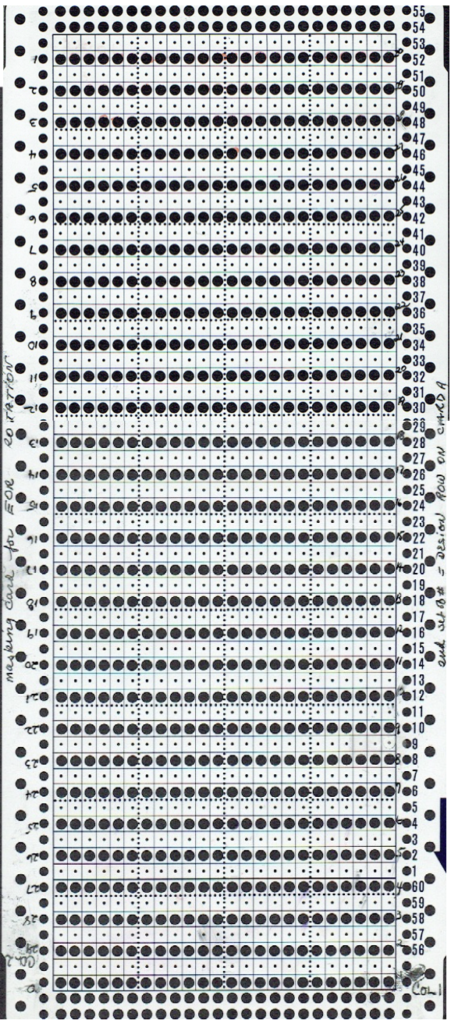 This separation works with any number of rows. The design will be elongated X2 in height because each design row knits twice in each color, with 4 rows completing it.
This separation works with any number of rows. The design will be elongated X2 in height because each design row knits twice in each color, with 4 rows completing it.
The finished knit will be thicker as well, so use thinner yarns when working it. Draw shapes in colors that are chosen for clear contrast, not because they are to be used in the finished piece.
Here I am back to those triangles used in earlier posts. The choice of which color you begin with, whether in the separation or in the knit is ultimately up to you. With the masked card, the first row is marked on the very bottom of your new design, I began with the red, which would produce the equivalent of this
With the masked card, the first row is marked on the very bottom of your new design, I began with the red, which would produce the equivalent of this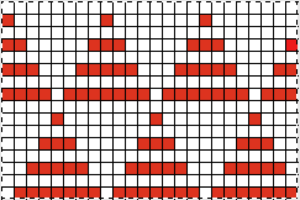 Remove the mask. Beginning with the second row from the bottom, mark any square not colored in the row below in a contrasting color
Remove the mask. Beginning with the second row from the bottom, mark any square not colored in the row below in a contrasting color 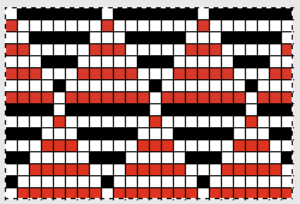 Punch all colored squares and you are ready to knit. I prefer to not rely on built-in elongation if I am making a garment or a long piece of knitting. If errors are made or correction of dropped stitches, loops, wrong color selection, etc. is required, unraveling rows is complicated enough without having to also sort out exactly where you need to be in relation to where the card did or did not advance. Black squares represent punched holes, a segment one separated by the red line in repeat width could be used on mylar or for electronic download.
Punch all colored squares and you are ready to knit. I prefer to not rely on built-in elongation if I am making a garment or a long piece of knitting. If errors are made or correction of dropped stitches, loops, wrong color selection, etc. is required, unraveling rows is complicated enough without having to also sort out exactly where you need to be in relation to where the card did or did not advance. Black squares represent punched holes, a segment one separated by the red line in repeat width could be used on mylar or for electronic download. 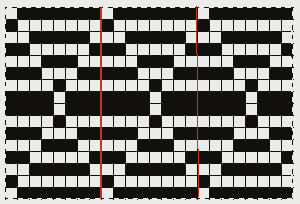 3: Another master for the elongated design, advancing every row, numbers represent rows being filled in, beginning with odd in this orientation, and even with the card rotated for marking even # rows in color 2
3: Another master for the elongated design, advancing every row, numbers represent rows being filled in, beginning with odd in this orientation, and even with the card rotated for marking even # rows in color 2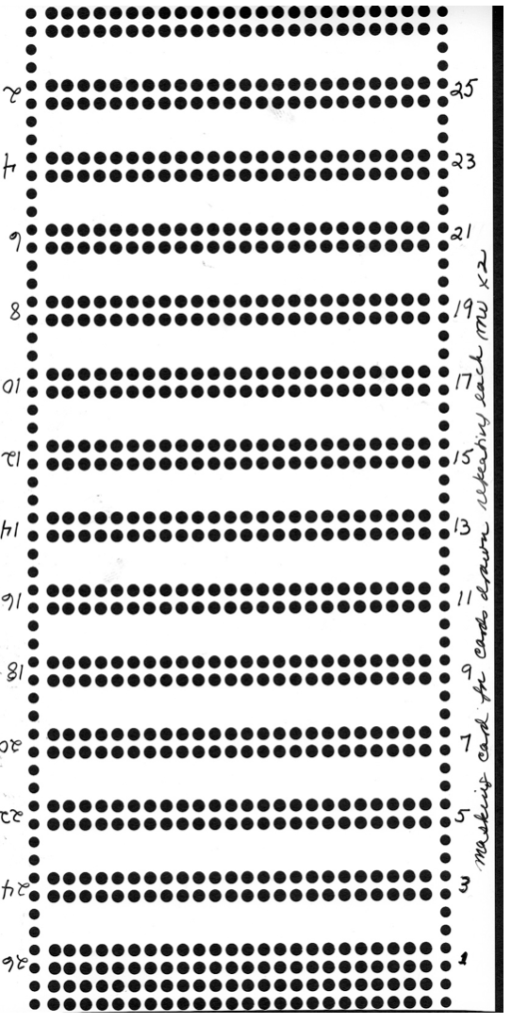 This is the same repeat, color-separated, and elongated X 2; proceed as with the directions above, but in this instance, each row in each color is marked twice. The expanded repeat:
This is the same repeat, color-separated, and elongated X 2; proceed as with the directions above, but in this instance, each row in each color is marked twice. The expanded repeat: The first preselection row is made from right to left toward the color changer, where colors are changed every two rows.
The first preselection row is made from right to left toward the color changer, where colors are changed every two rows.
I have used these images to illustrate color separations in far older posts.
 The reason the resulting separation here looks so different from the one above is simply that in this latest series of charts the color selections have essentially been inverted. The inversion creates a mirror
The reason the resulting separation here looks so different from the one above is simply that in this latest series of charts the color selections have essentially been inverted. The inversion creates a mirror  mirrored back to the original orientation with the inverted colors in place, and the color reverse is now recognizable
mirrored back to the original orientation with the inverted colors in place, and the color reverse is now recognizable
As a matter of course it is helpful to be consistent in the choice of starting color when separating motifs. Any single repeats isolated from above are usable in electronic machines, reduced to black and white pixels.
Electronic automated separations vary in terms of choosing black or white squares for the first row knit, whether you download an original image or work with built-in ones. With the preselection of needles in Brother or pushers in Passap, with an easy-to-count color repeat and some air knitting, planning starting color of choice and needle placement can be sorted out for more confidence when actual knitting starts.
If you would prefer to work on graph paper that matches the size of your punchcard, there is a downloadable PDF and word doc with some guidelines in my previous posts more-low-tech/ and creating knit graph paper. The posts were in 2011 and 2014, with illustrations drafted in earlier versions of OS and apps. Working in Pages I was now able to print an image just about to perfect scale to part of a blank factory card. Here is part of the first repeat in this post traced through the punchcard holes onto it:
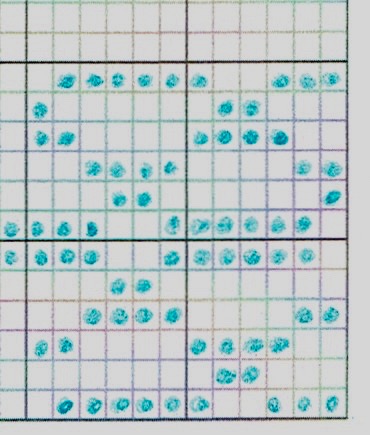 I then exported 2 documents, one to Word, and the other to PDF. The first printed image and the PDF one (opened in Preview) were printed to an identical scale using my Epson Printer, and a Brother one in 2025.
I then exported 2 documents, one to Word, and the other to PDF. The first printed image and the PDF one (opened in Preview) were printed to an identical scale using my Epson Printer, and a Brother one in 2025.
Here are the new docs to try, they may need tweaking.
I cannot proof the Excel exports.
My measurements, adjusted in Pages were 11 cm by 18.2, for 30 rows in card height: PDF no numbers card, prints out to scale. Word doc for same exported from Pages no numbers card is untested.
I have found squares of the blank card PNG opened as BMP may be filled in either GIMP or Paint, but the printed size is not in the same aspect ratio as the printout of the original blank cells PDF.
If the scale does not matter and you prefer convenience, this is a numbered “full” punchcard template as PDF scaled to fit on a single page punchcard numbered, and as an editable Excel document exported from Mac Numbers: punchcard templates_ excel

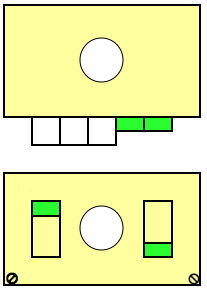




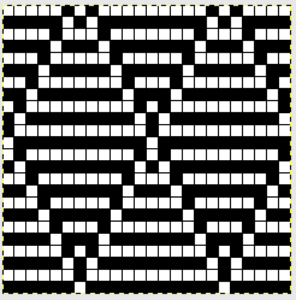
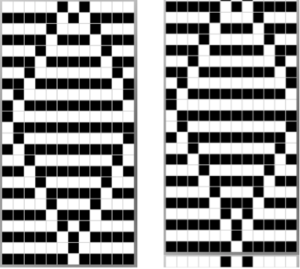

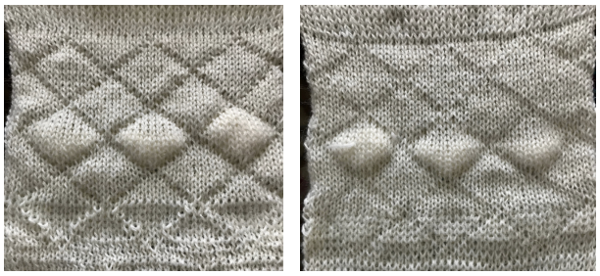
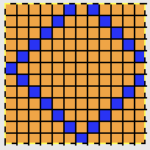

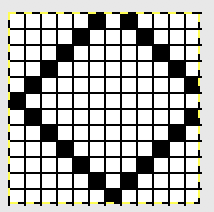
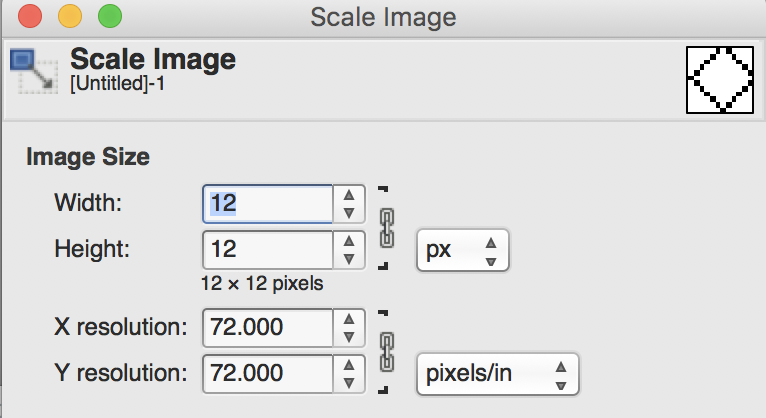


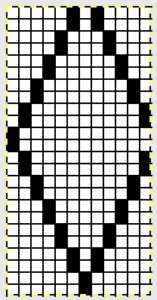
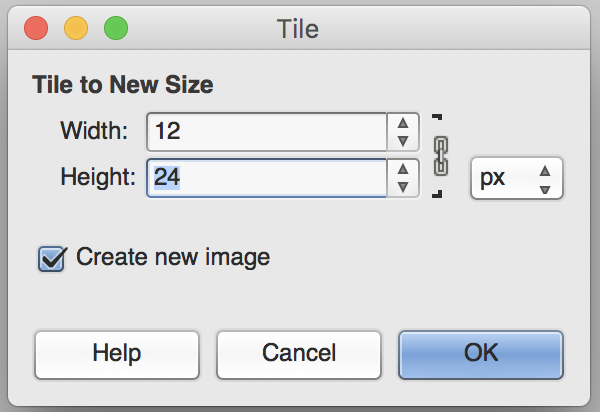

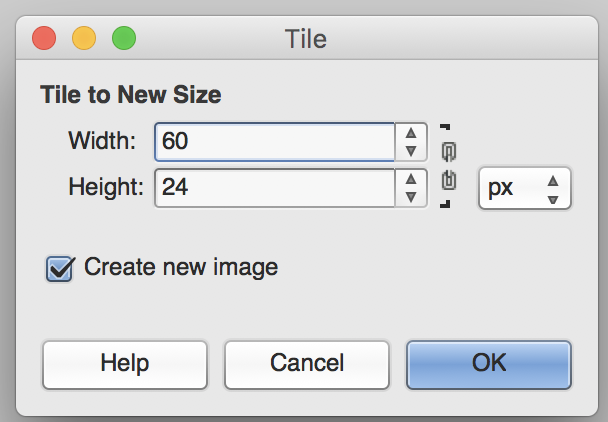
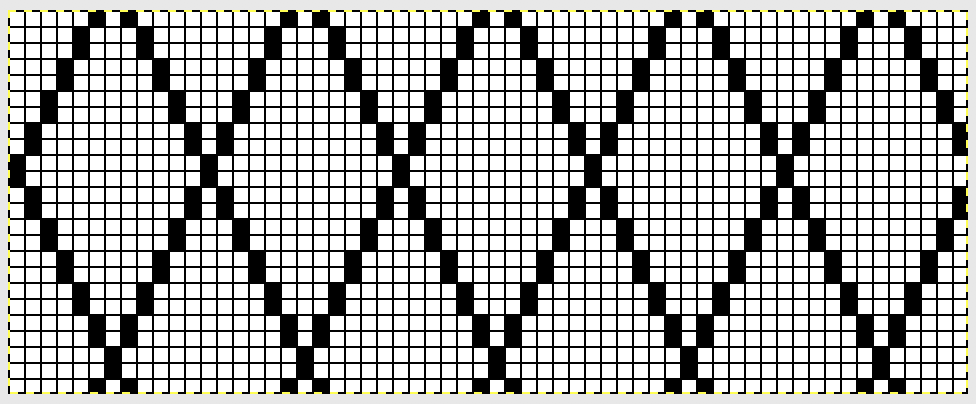


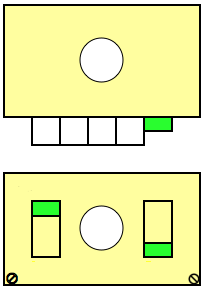
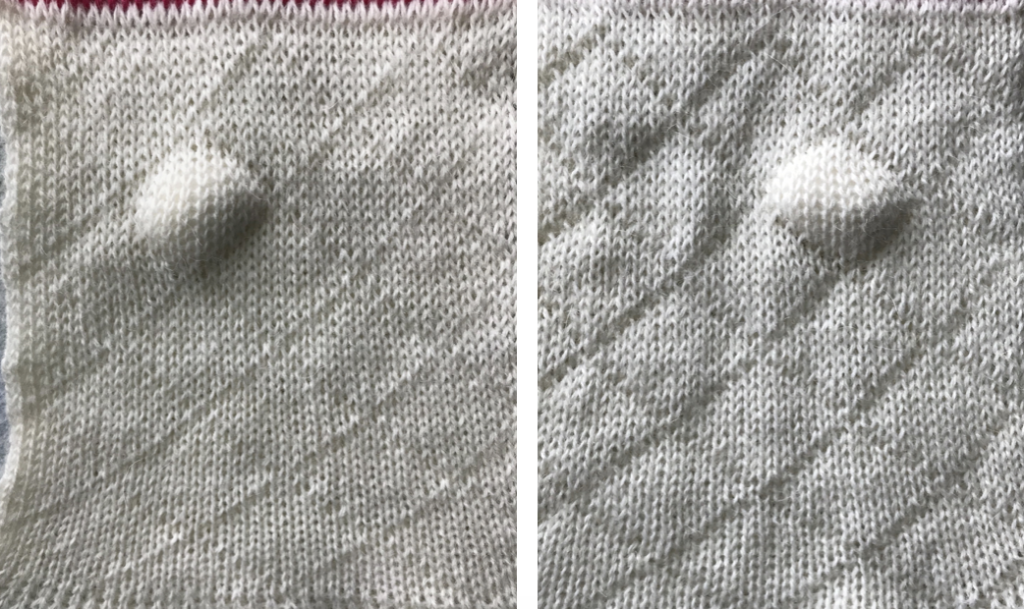
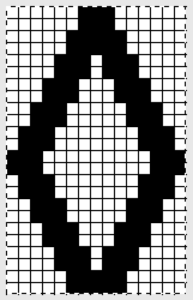
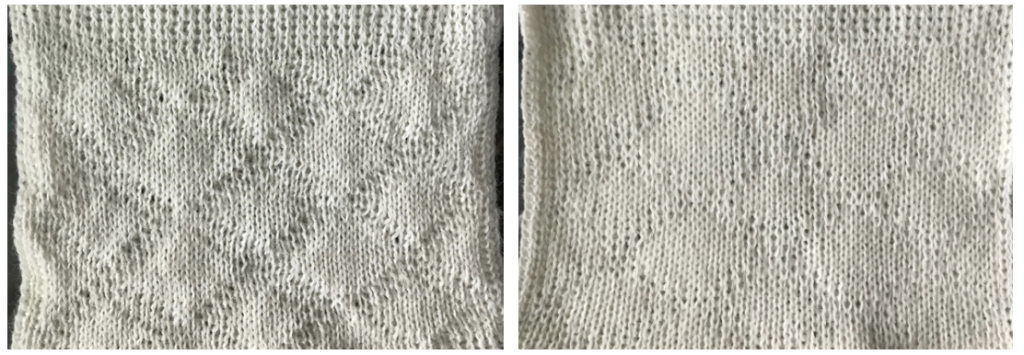
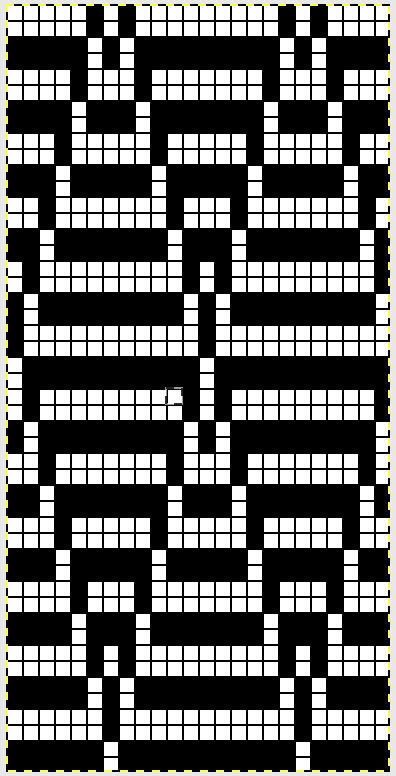


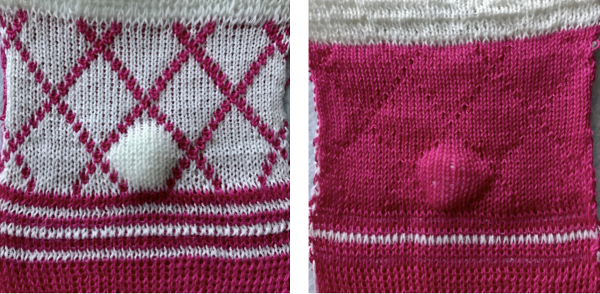



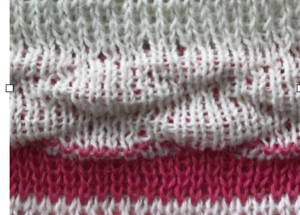
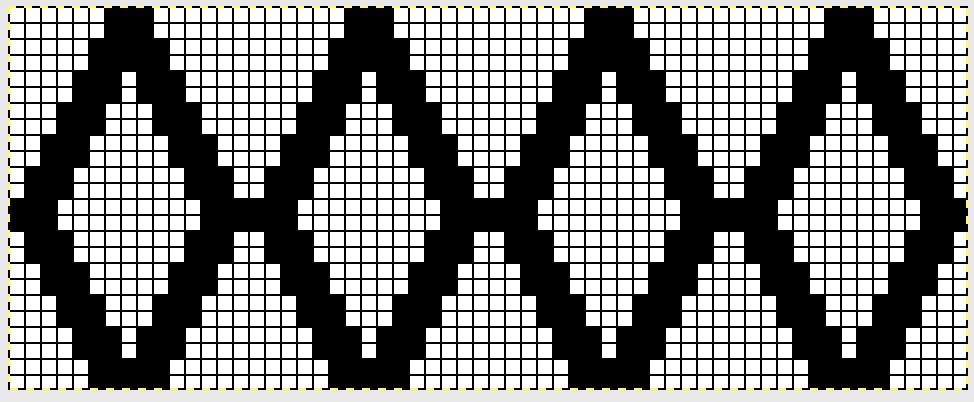 I chose to continue to test on a narrower repeat. An added consideration: in knitting fair isle, the first and last needle on each side is normally selected whether by using change knob on KC I in 910, or adjusting knit under carriage in punchcard machines. One can program black squares on either side of the full pattern repeat for the width of the fabric to insure that any number of edge stitches knit every row on each side. Working on a smaller repeat, now 47 X 24
I chose to continue to test on a narrower repeat. An added consideration: in knitting fair isle, the first and last needle on each side is normally selected whether by using change knob on KC I in 910, or adjusting knit under carriage in punchcard machines. One can program black squares on either side of the full pattern repeat for the width of the fabric to insure that any number of edge stitches knit every row on each side. Working on a smaller repeat, now 47 X 24

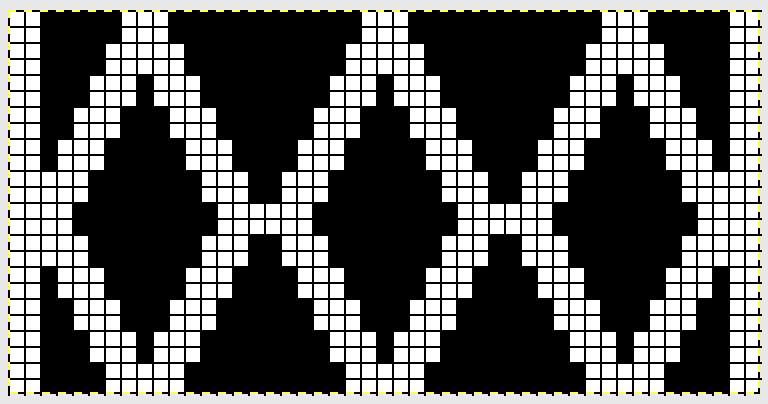


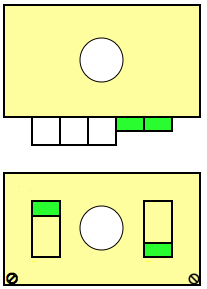






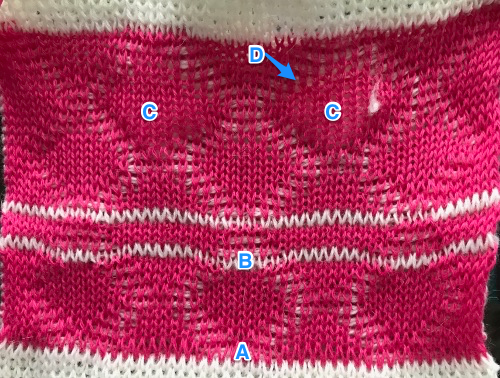
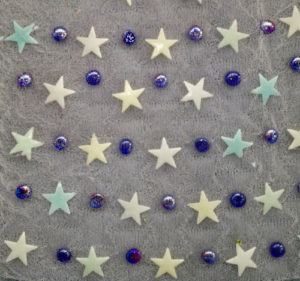

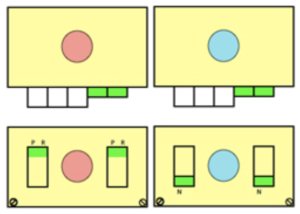
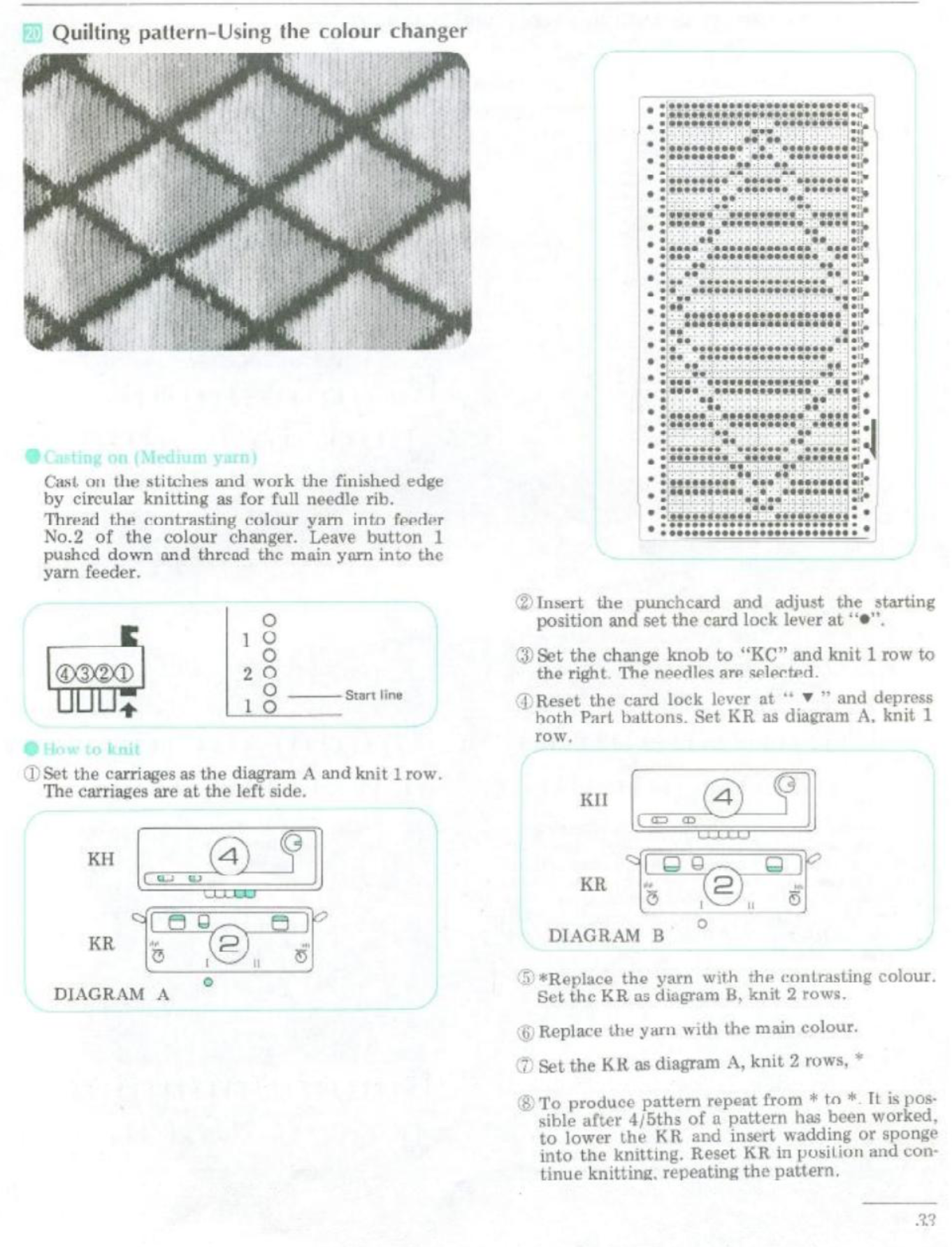
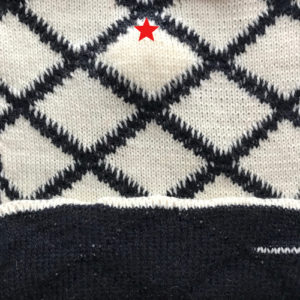

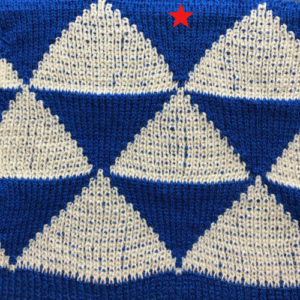
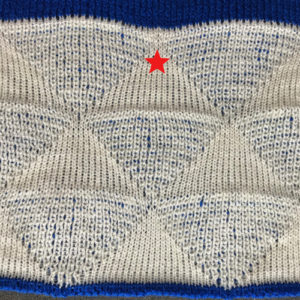

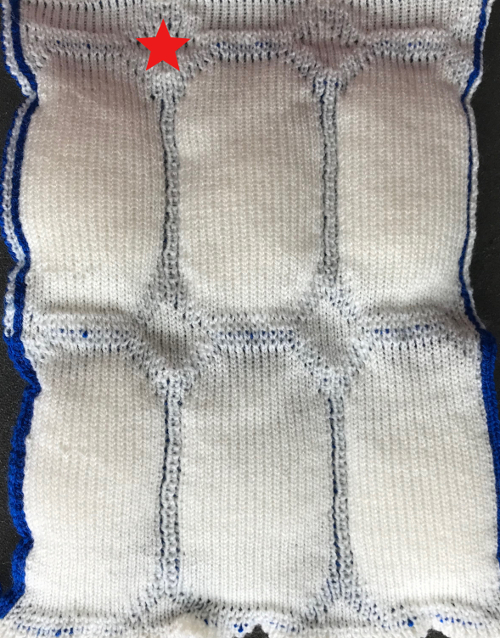
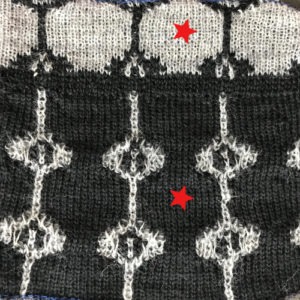



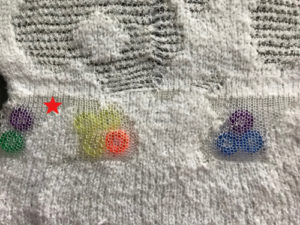


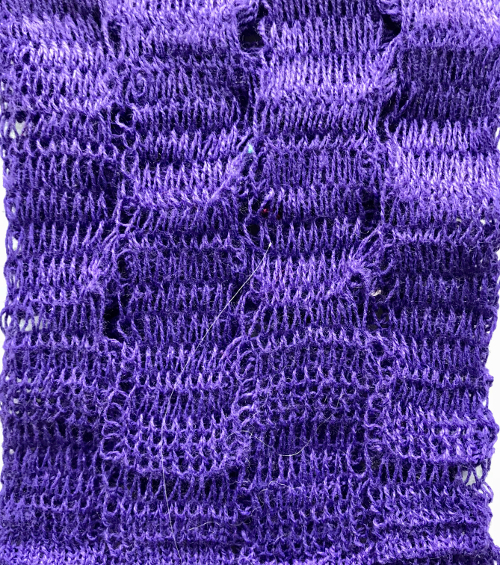
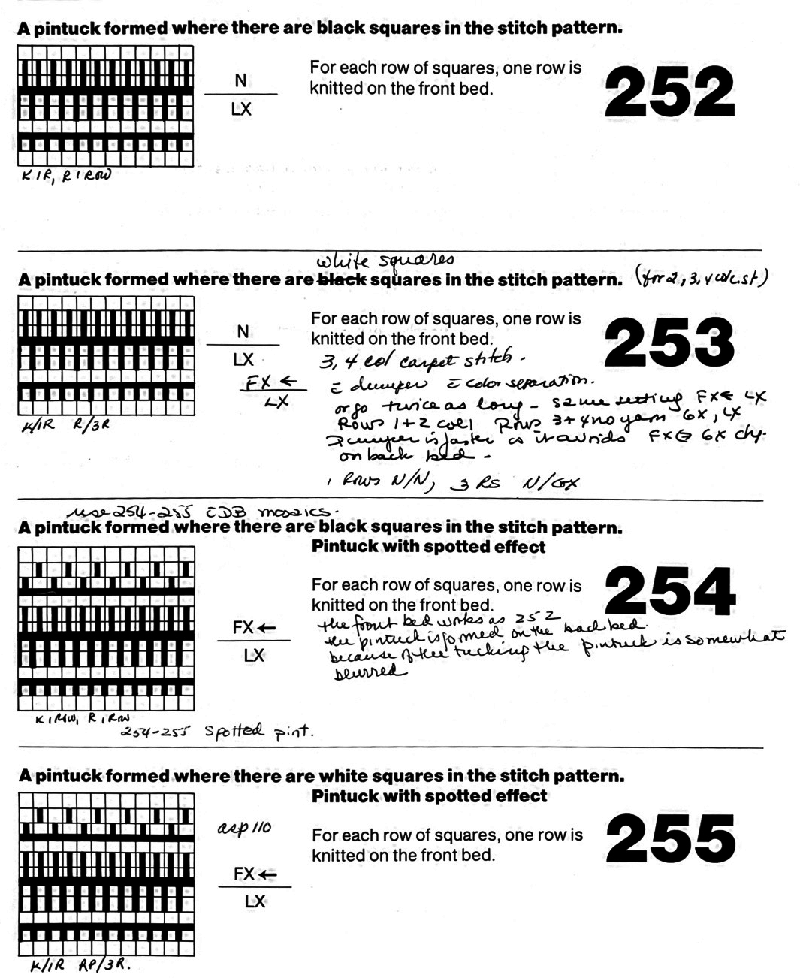
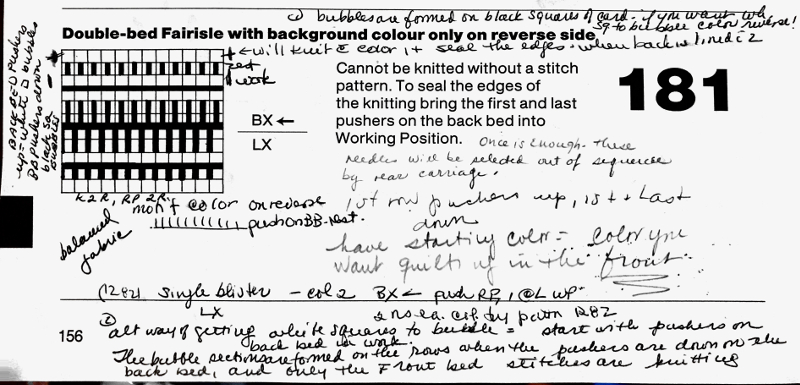


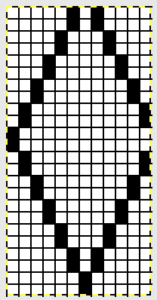


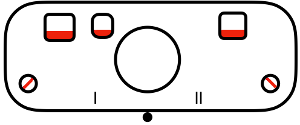
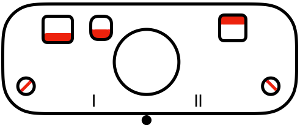




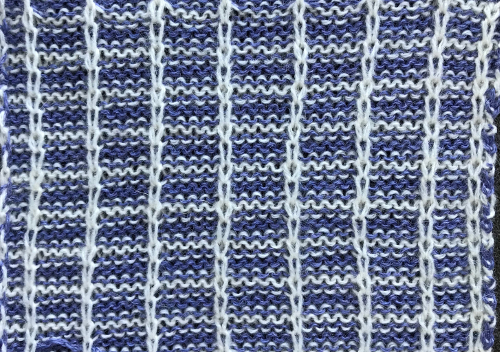
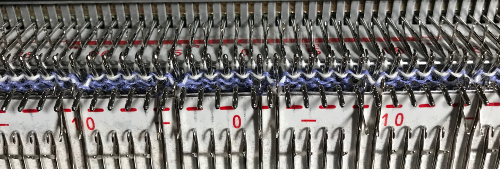

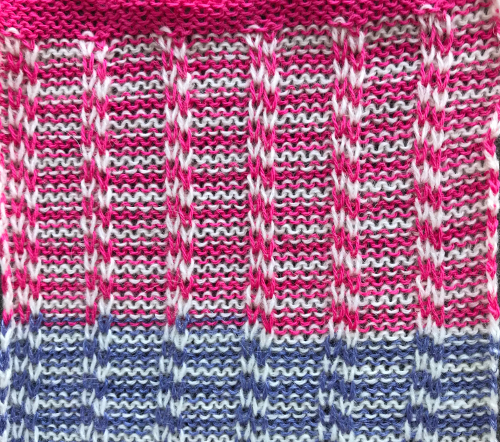
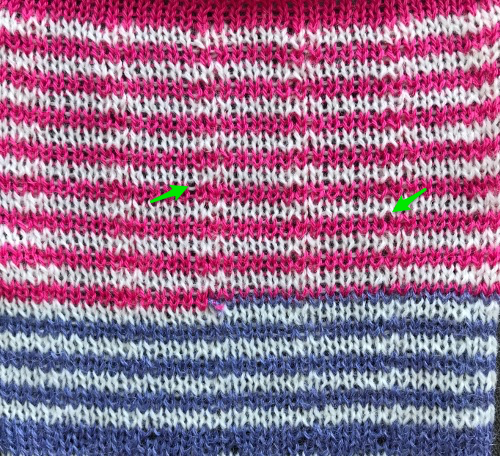



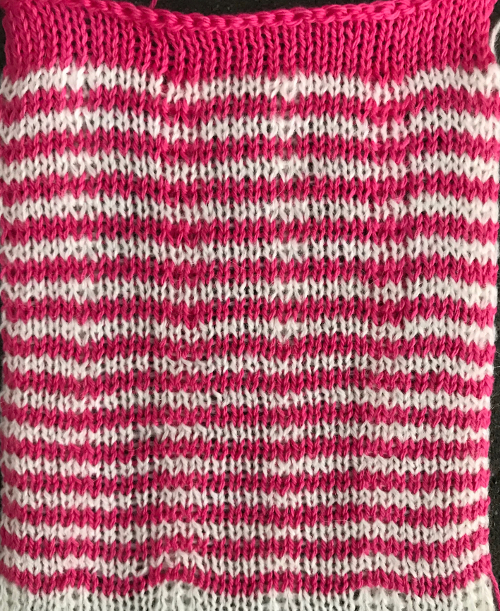
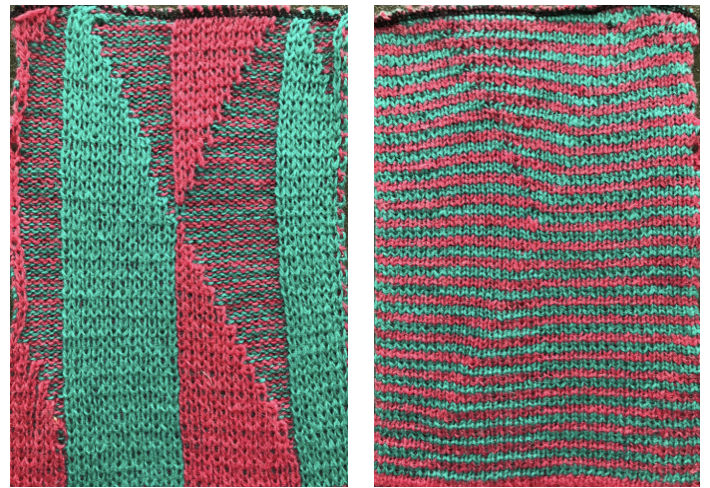


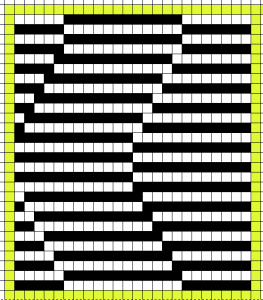
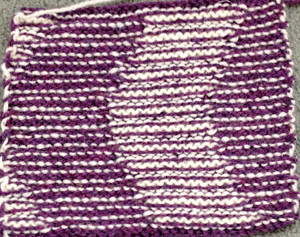 the color-separated sample knit pre ayab
the color-separated sample knit pre ayab 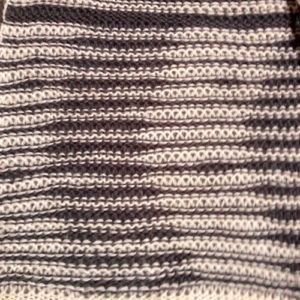


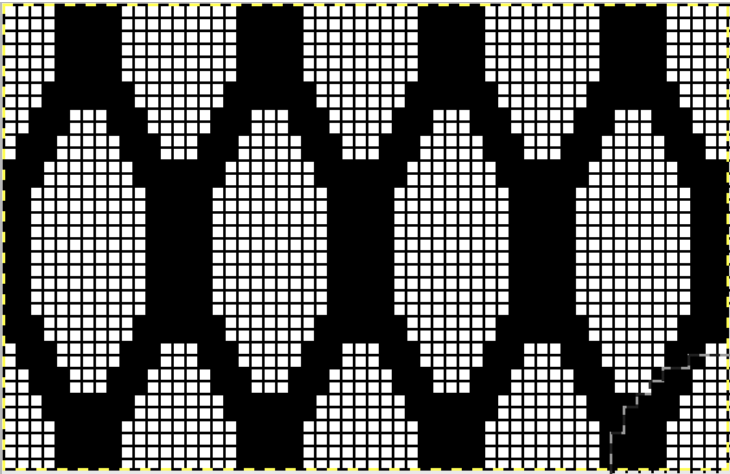
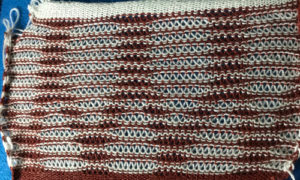
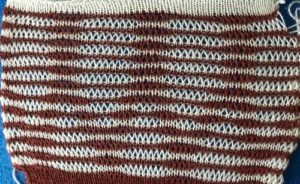
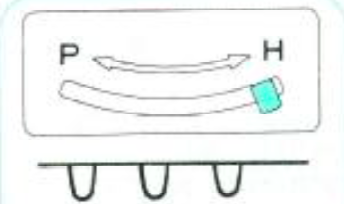





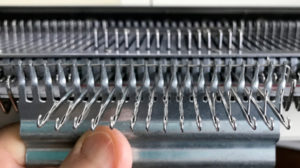

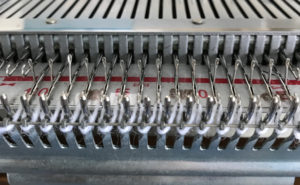
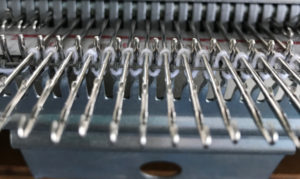
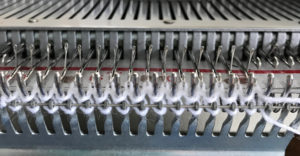
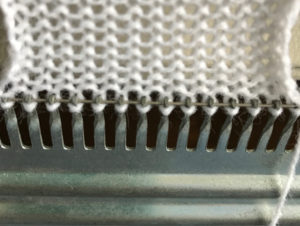

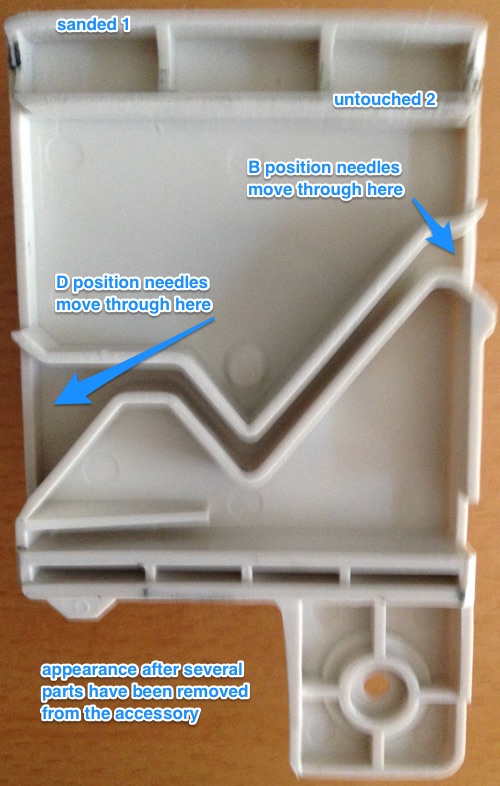
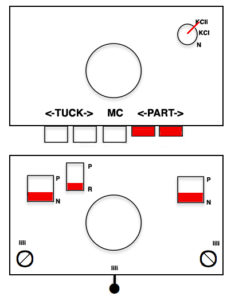

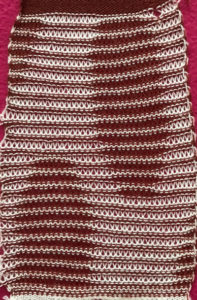
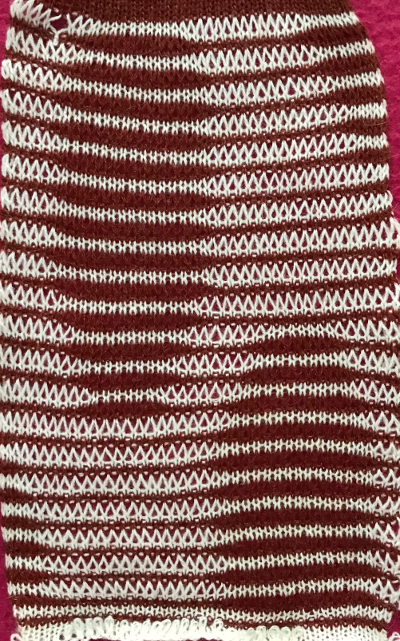
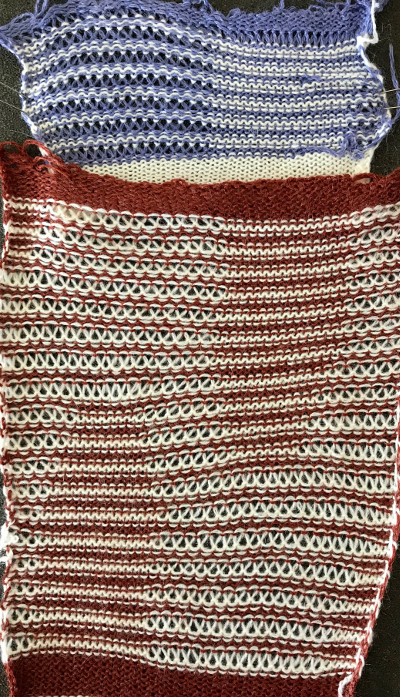


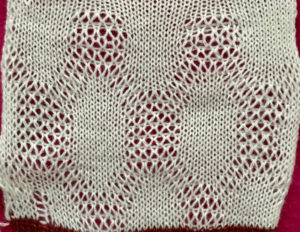
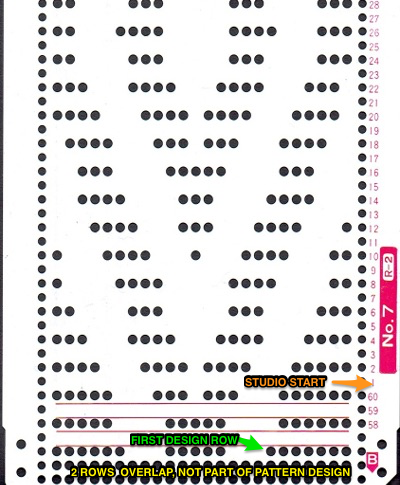
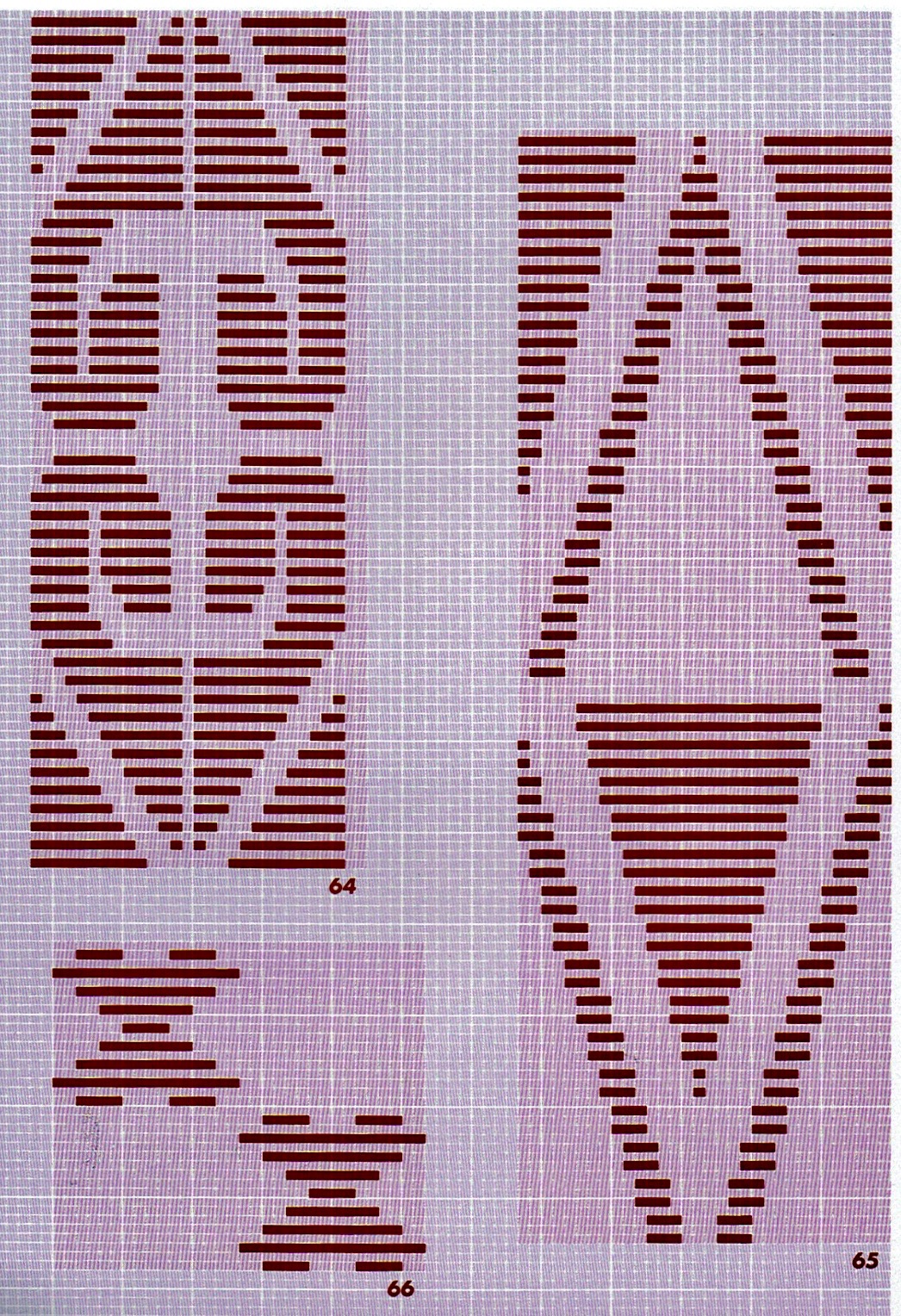

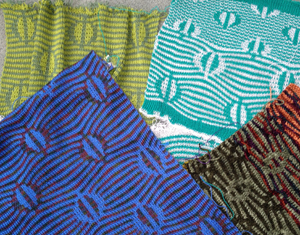
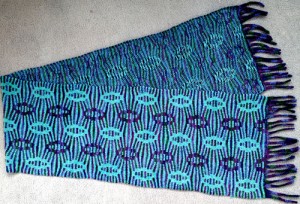
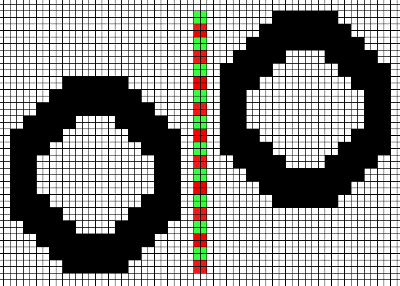
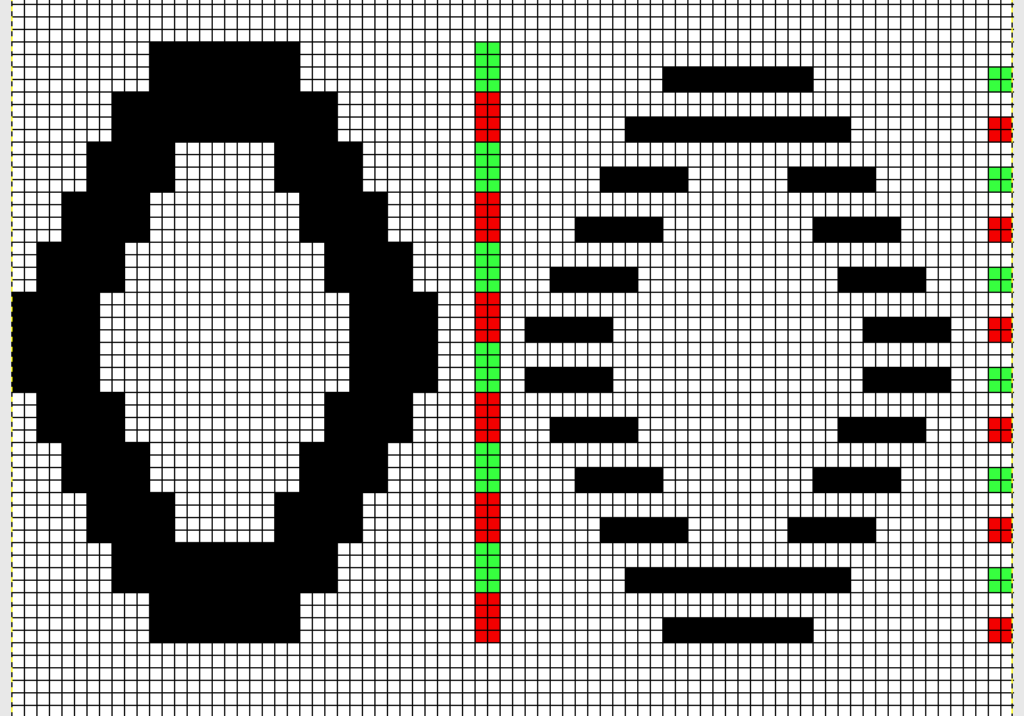



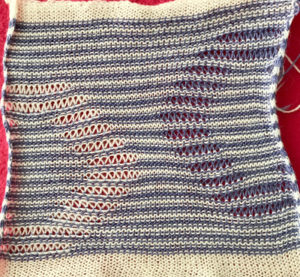
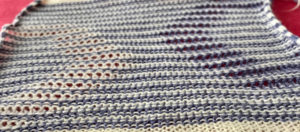



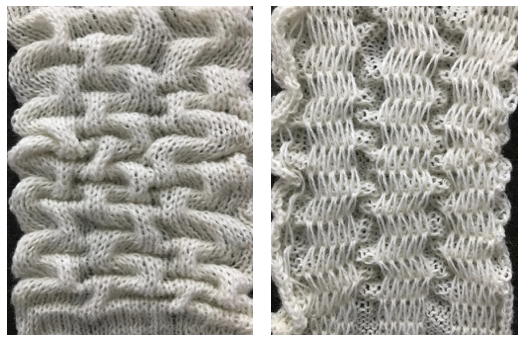



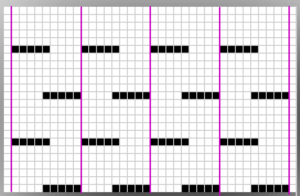



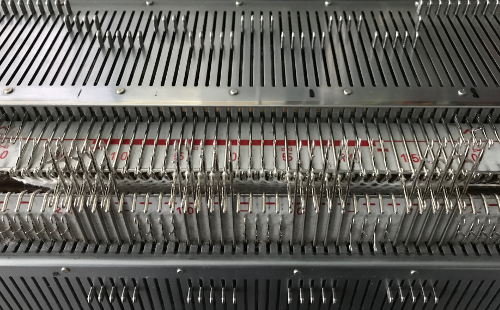

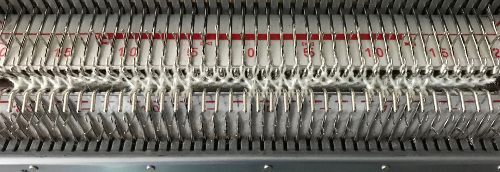




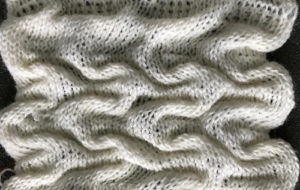

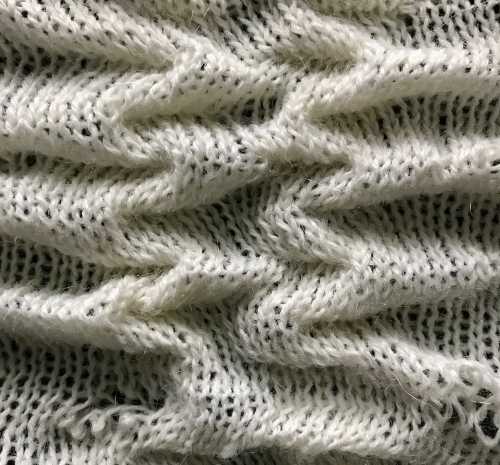






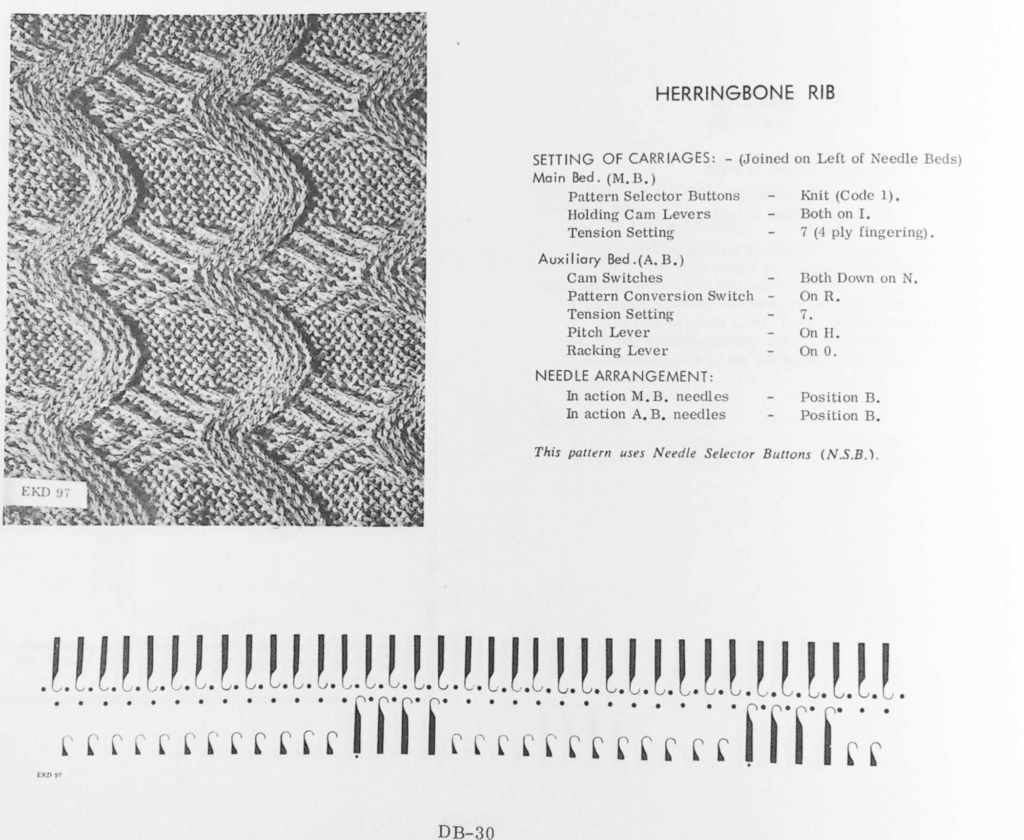



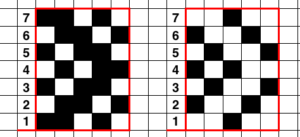

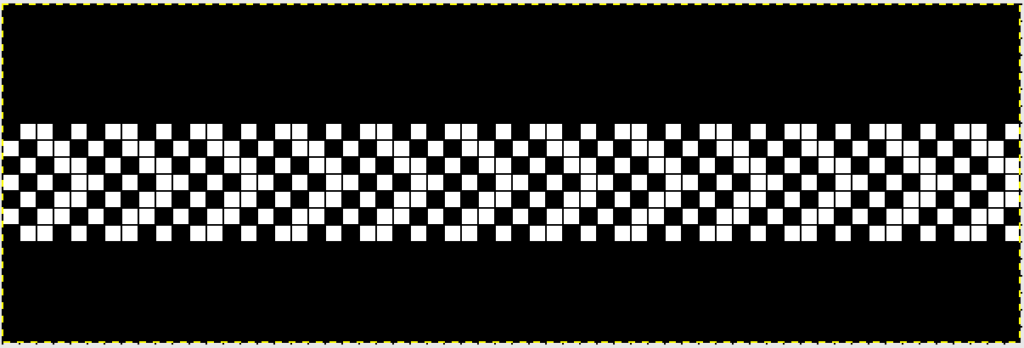
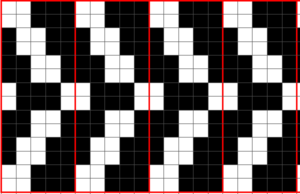




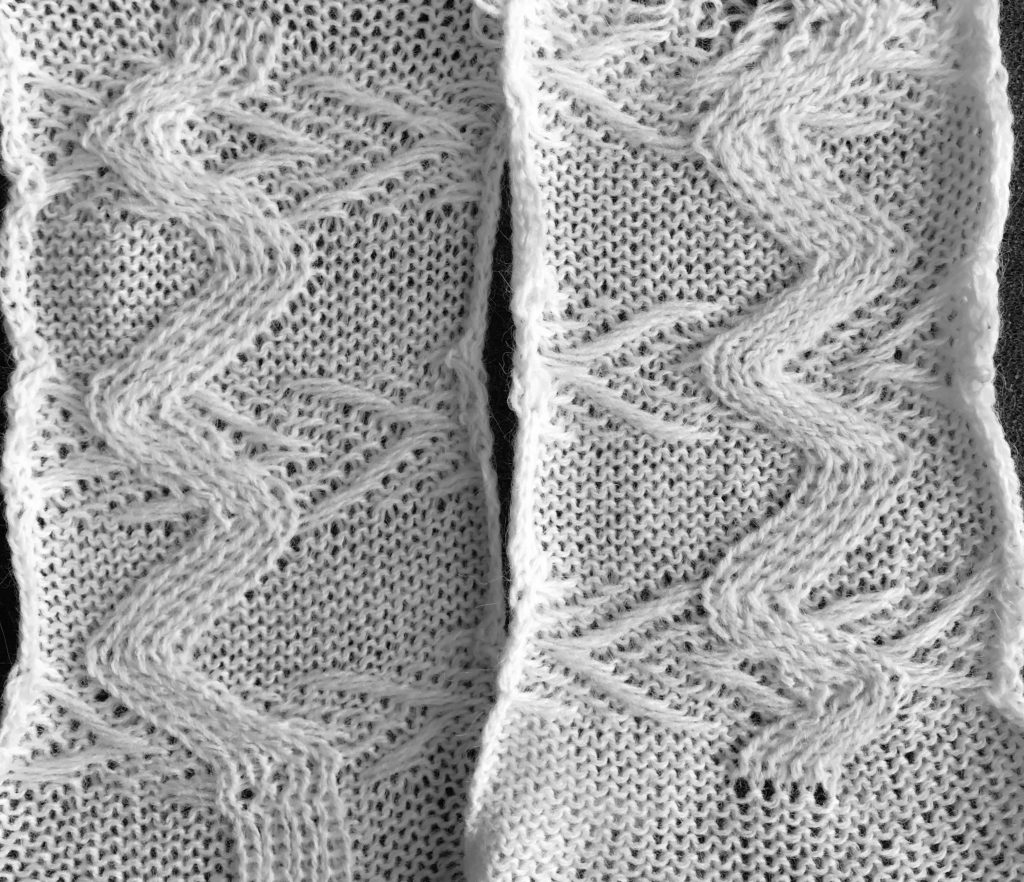

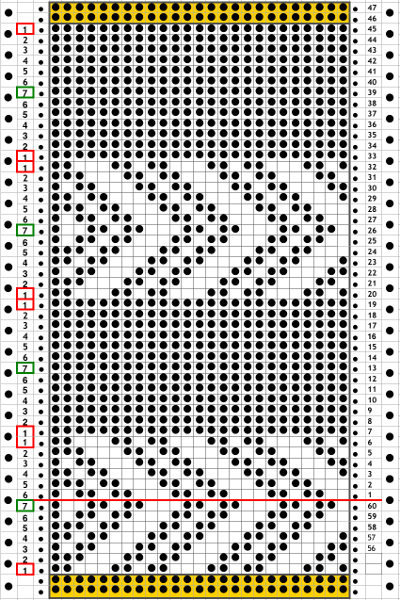

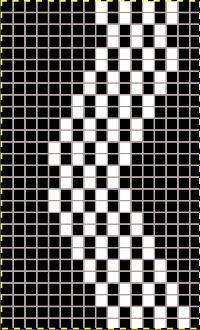 The repeat required mirroring for use in my electronic 930. Experimenting with racking intersecting tuck stitch on multiple repeat png, stitches were picked up on the ribber aside from the first tuck stitch on the right, A, on the center, B, and on the left, C, of the knit stitch groups.
The repeat required mirroring for use in my electronic 930. Experimenting with racking intersecting tuck stitch on multiple repeat png, stitches were picked up on the ribber aside from the first tuck stitch on the right, A, on the center, B, and on the left, C, of the knit stitch groups.
 changing ribber needle positions
changing ribber needle positions moving toward positioning the racked pattern further into the knit columns.
moving toward positioning the racked pattern further into the knit columns. 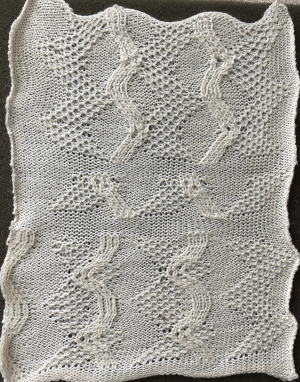

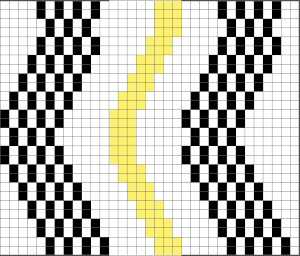 Good notes and documentation of the final needle arrangement will make the technique easily reproducible. The needles involved on the top bed always need to be returned to the patterning position after any shares.
Good notes and documentation of the final needle arrangement will make the technique easily reproducible. The needles involved on the top bed always need to be returned to the patterning position after any shares.  At any point in the knitting, it is easy enough to transfer stitches on the ribber up to the main bed, drop the ribber down, and check on the placement of the racked pattern. If the place is satisfactory, the moved stitches can be returned to the ribber and the work is continued. If not, transferred stitches can be left on the main bed, other stitches can be shared with the ribber and patterning can continue with racking in the new location. One such adjustment is seen toward the bottom of this swatch.
At any point in the knitting, it is easy enough to transfer stitches on the ribber up to the main bed, drop the ribber down, and check on the placement of the racked pattern. If the place is satisfactory, the moved stitches can be returned to the ribber and the work is continued. If not, transferred stitches can be left on the main bed, other stitches can be shared with the ribber and patterning can continue with racking in the new location. One such adjustment is seen toward the bottom of this swatch. 
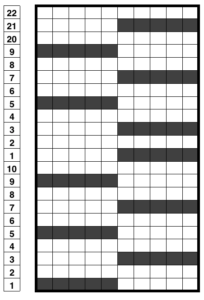
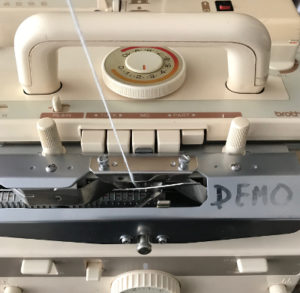 the start of the tube, needle selection for first pattern row
the start of the tube, needle selection for first pattern row 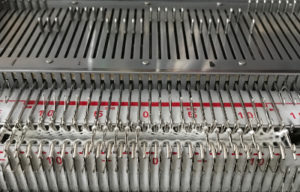
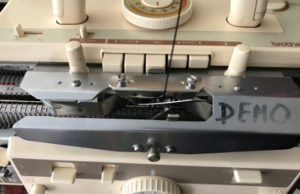 the start of a tube is evident if the ribber is dropped a bit
the start of a tube is evident if the ribber is dropped a bit 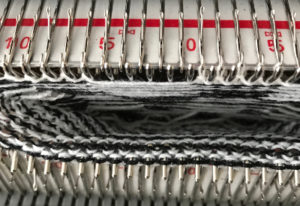 the tube dropped off the machine
the tube dropped off the machine  the FI created on the main bed
the FI created on the main bed 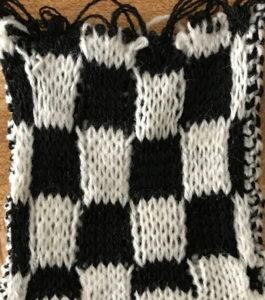 the pattern on the reverse, created by ribber
the pattern on the reverse, created by ribber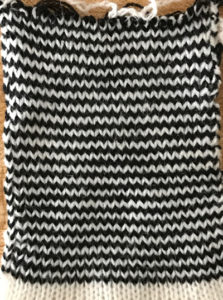
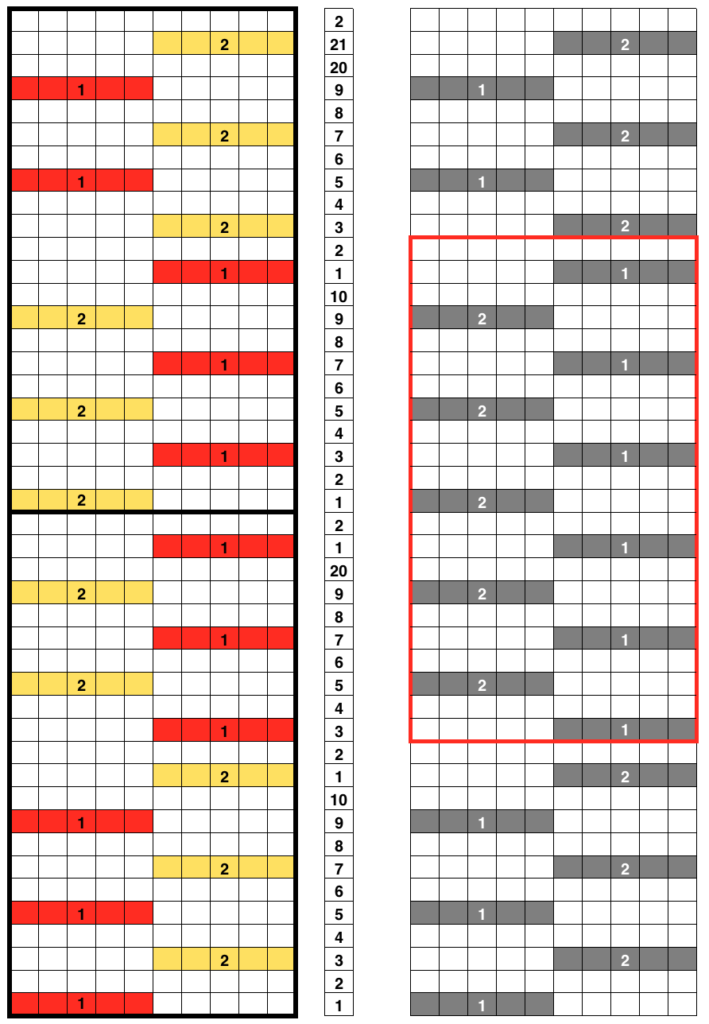
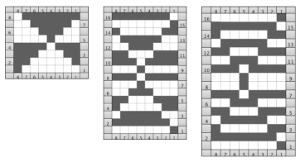




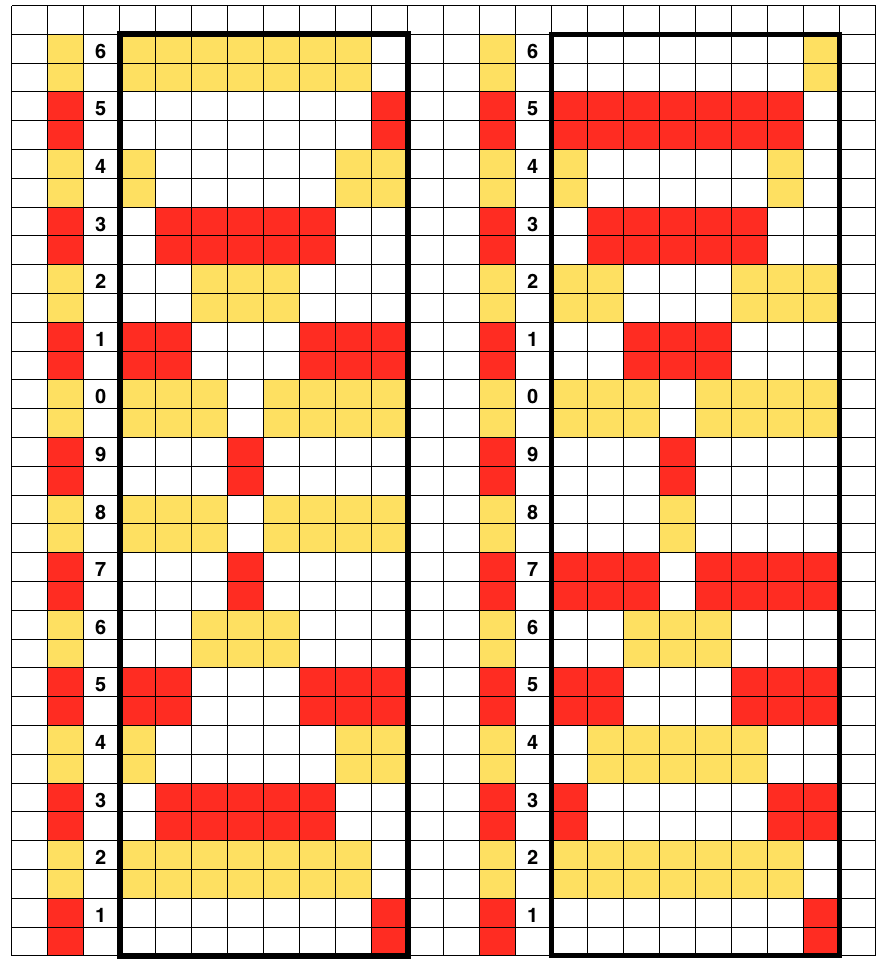
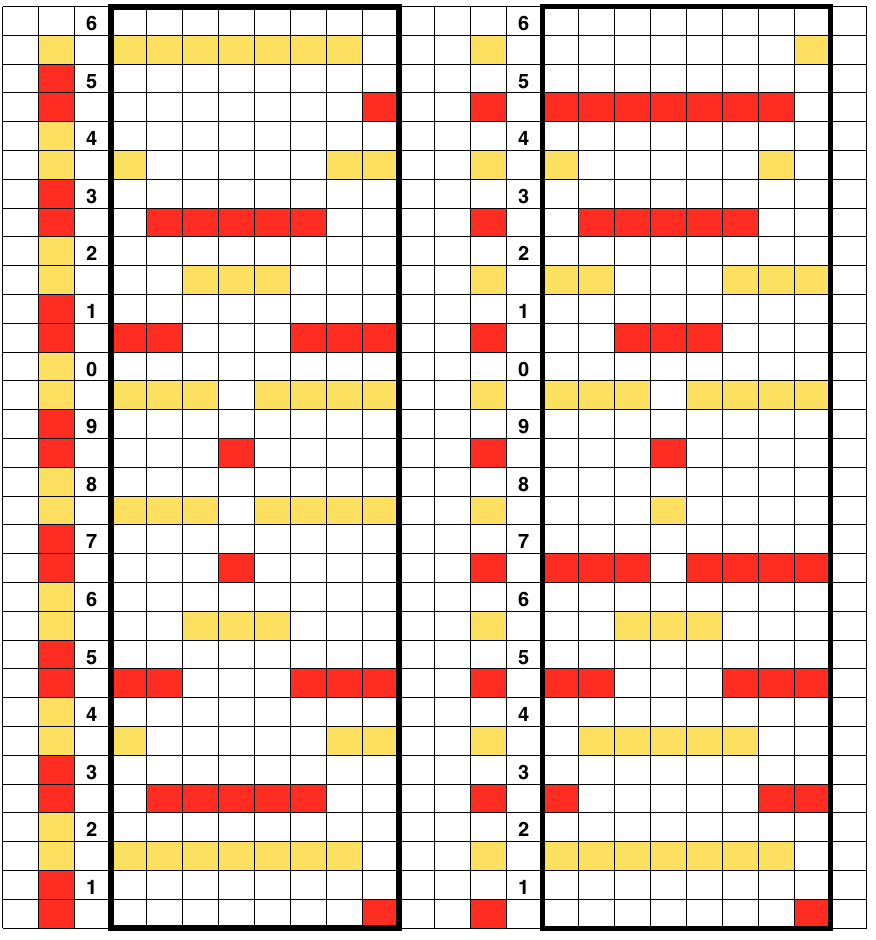 this shows what happens when the first separation is collapsed into what actually gets knit by the carriages in this technique
this shows what happens when the first separation is collapsed into what actually gets knit by the carriages in this technique and the result in repeat in B/W like my swatch
and the result in repeat in B/W like my swatch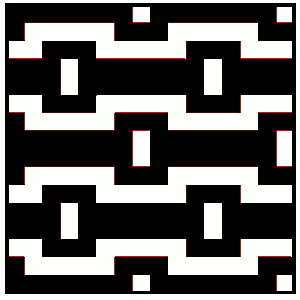



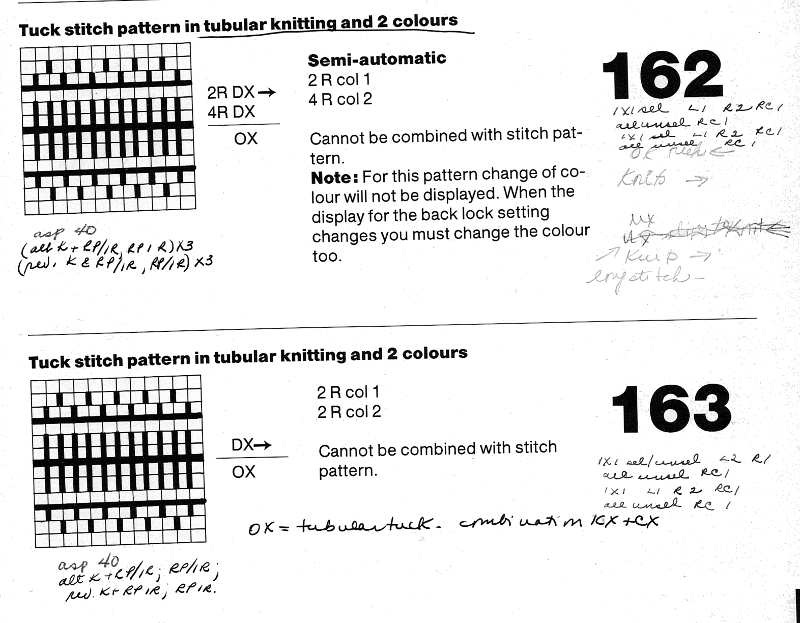
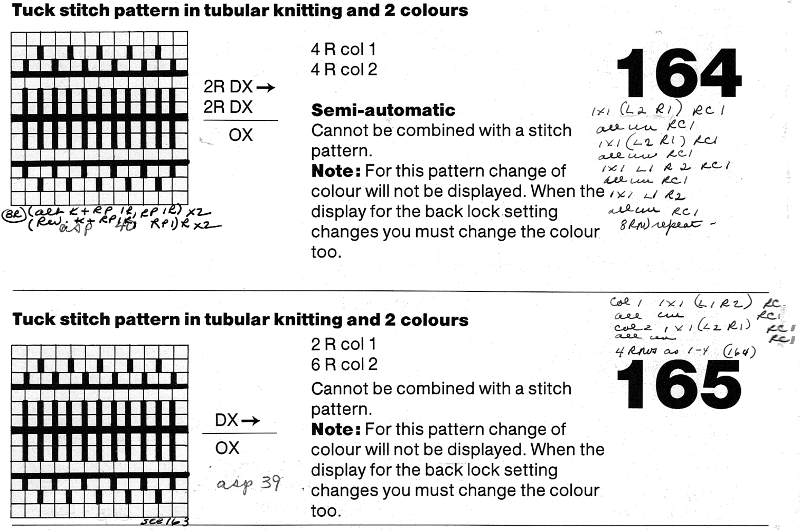 For tucked 2 colors fair isle use technique 185 with lock set on N/OX.
For tucked 2 colors fair isle use technique 185 with lock set on N/OX. 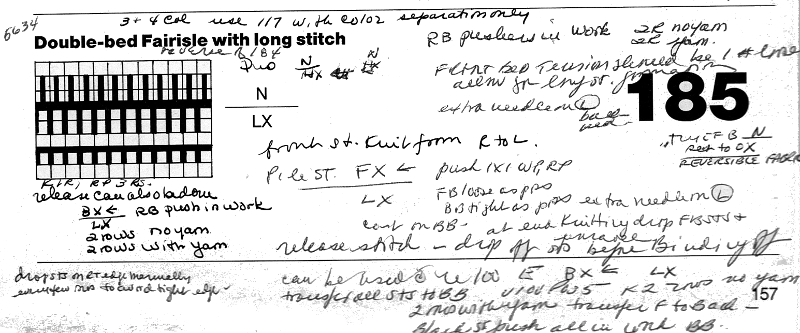


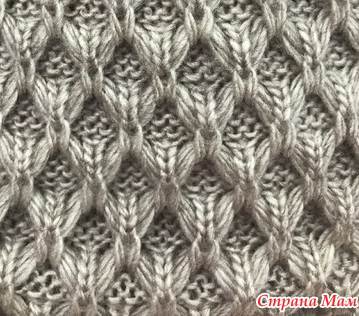 This is my first experiment with gathered slip stitch floats on the purl side of the knit. To begin, this chart indicates one punchcard pattern’s full repeat in width. Four repeats in length would be required (the punchcard minimum repeat in length to achieve smooth continuous card feeding is 36 rows). Punch out blue squares, leaving white ones unpunched. A single repeat (outlined in black, 8 stitches by 12 rows) is for use in electronic patterning, where one may alternately draw or program white squares, then use color reverse. The red line represents 0 needle position in Brother KM
This is my first experiment with gathered slip stitch floats on the purl side of the knit. To begin, this chart indicates one punchcard pattern’s full repeat in width. Four repeats in length would be required (the punchcard minimum repeat in length to achieve smooth continuous card feeding is 36 rows). Punch out blue squares, leaving white ones unpunched. A single repeat (outlined in black, 8 stitches by 12 rows) is for use in electronic patterning, where one may alternately draw or program white squares, then use color reverse. The red line represents 0 needle position in Brother KM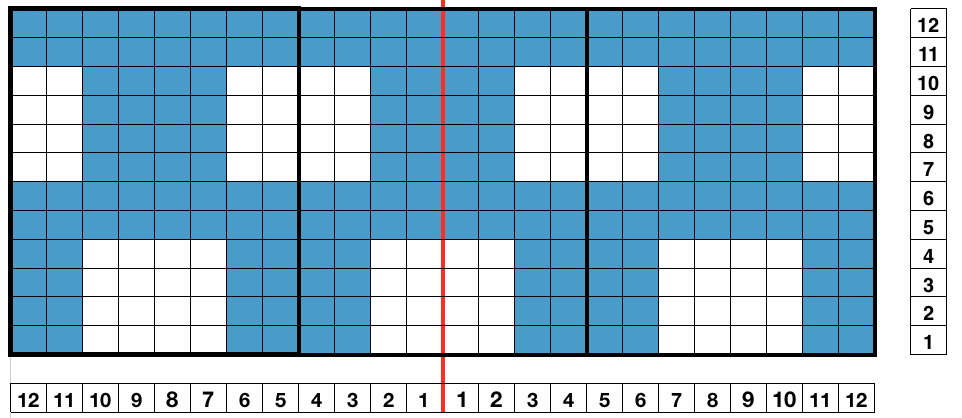

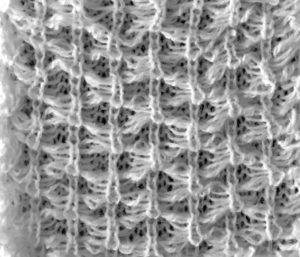 result with color reverse
result with color reverse 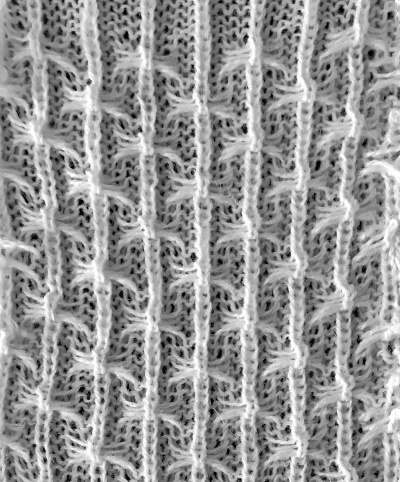 working out a mylar, electronic (unless DM 80 40 stitch width is in use) repeat for a variation of the fabric knit single bed. The stitch count is odd, allowing for a center stitch manipulation. KCI is used to make certain the first and last needles knit on each side. Floats created close to edges may be left without hooking them up. The fabric separates slightly along the “bowknot” edges
working out a mylar, electronic (unless DM 80 40 stitch width is in use) repeat for a variation of the fabric knit single bed. The stitch count is odd, allowing for a center stitch manipulation. KCI is used to make certain the first and last needles knit on each side. Floats created close to edges may be left without hooking them up. The fabric separates slightly along the “bowknot” edges 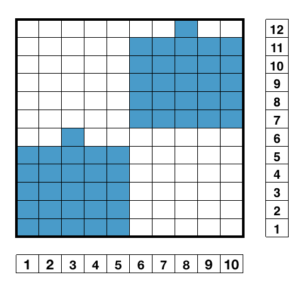

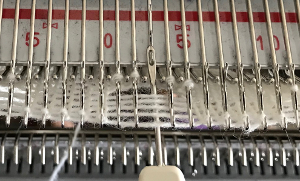 lift them up and onto that single non selected needle, push that needle out to hold
lift them up and onto that single non selected needle, push that needle out to hold with the next pass the single needle and loops knit off together and become part of the alternating all knit block in the design
with the next pass the single needle and loops knit off together and become part of the alternating all knit block in the design the swatches are knit in a 2/15 wool, the fabric might be better served using a thicker yarn. Here the “blocks” creating “floats” are side by side
the swatches are knit in a 2/15 wool, the fabric might be better served using a thicker yarn. Here the “blocks” creating “floats” are side by side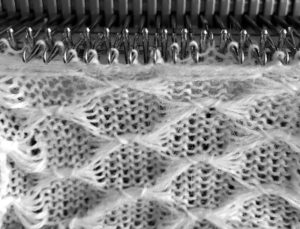
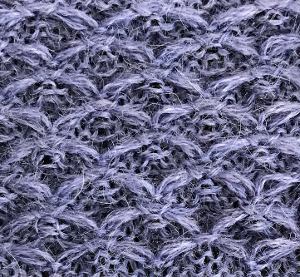
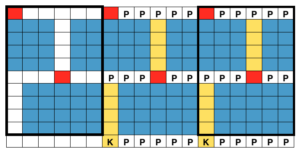 adding border stitches, and more theory on the placement of stitch type
adding border stitches, and more theory on the placement of stitch type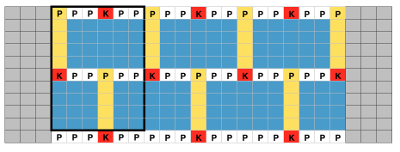 the result places “knit” stitches in the center of butterfly (magenta arrow), not at its sides, and I see and extra purl stitch (green arrow). Multiple stitch-wide borders create unwanted floats on one side
the result places “knit” stitches in the center of butterfly (magenta arrow), not at its sides, and I see and extra purl stitch (green arrow). Multiple stitch-wide borders create unwanted floats on one side back to the drawing board and working things out first as a hand technique
back to the drawing board and working things out first as a hand technique
 I began with my carriage on the right (COR), after setting up the repeat on a multiple of 6 stitches +3 as indicated above. The last stitch on either side on both beds is never transferred, and the short loops of every other set (rows 5 and 17 in the chart) are not hooked up. This will produce a slightly rolled edge on each side. The larger number of border stitches becomes problematic. The photos were taken while knitting 2 different swatches, so needle tape markings are not the same in all photos. To produce the circular knit, opposite part buttons are pushed in so with carriage on the right (COR), the settings would be
I began with my carriage on the right (COR), after setting up the repeat on a multiple of 6 stitches +3 as indicated above. The last stitch on either side on both beds is never transferred, and the short loops of every other set (rows 5 and 17 in the chart) are not hooked up. This will produce a slightly rolled edge on each side. The larger number of border stitches becomes problematic. The photos were taken while knitting 2 different swatches, so needle tape markings are not the same in all photos. To produce the circular knit, opposite part buttons are pushed in so with carriage on the right (COR), the settings would be
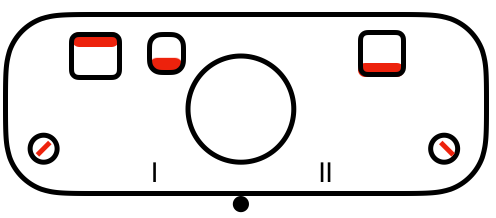
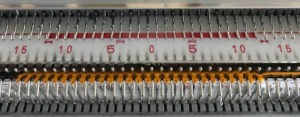

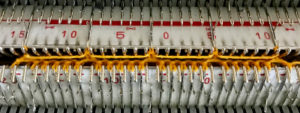
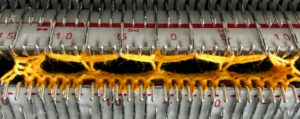 after the three floats have been hooked up, with COL each time, the in-between main bed stitches are transferred back down to ribber
after the three floats have been hooked up, with COL each time, the in-between main bed stitches are transferred back down to ribber
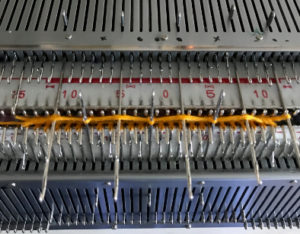
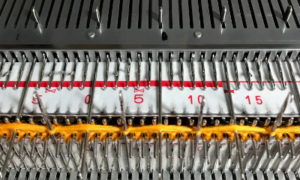

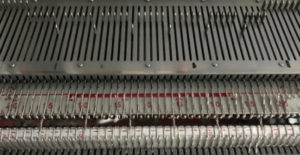
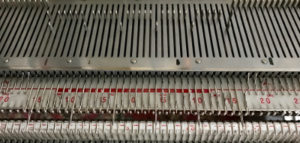 reducing main bed count so only one needle is left on either side of a selected one
reducing main bed count so only one needle is left on either side of a selected one  that needle (green arrow, gets transferred down to ribber
that needle (green arrow, gets transferred down to ribber  now the number of needles involved on both beds is evident on both beds
now the number of needles involved on both beds is evident on both beds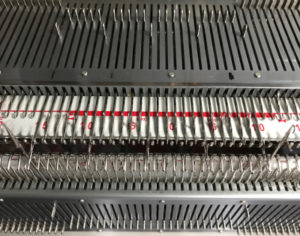 While knitting in the pattern the ribber pitch is set on P (point to point) to keep stitches on opposing beds centered (P pitch also makes it easier to transfer directly from one bed to the other). If the cast-on is for every other needle rib with stitches then transferred between beds for pattern knitting set up, the cast-on and all rib rows need to be knit in H pitch, with a switch to P for transfers and knitting in pattern to be completed. With the first row set up on the selected segment of the needle bed, there are additional steps to take.
While knitting in the pattern the ribber pitch is set on P (point to point) to keep stitches on opposing beds centered (P pitch also makes it easier to transfer directly from one bed to the other). If the cast-on is for every other needle rib with stitches then transferred between beds for pattern knitting set up, the cast-on and all rib rows need to be knit in H pitch, with a switch to P for transfers and knitting in pattern to be completed. With the first row set up on the selected segment of the needle bed, there are additional steps to take.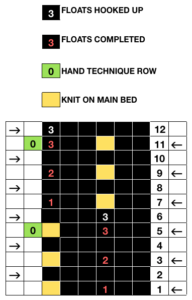
 Hand techniques will now also occur when carriages are on the left, on RC 5, 11, etc as described in the hand technique chart, on rows with no needle selection. As in hand tech, transfers and multiple loops containing needles are brought out to hold before moving the carriages from left to right and selecting the needles for the next set of floats with that same pass.
Hand techniques will now also occur when carriages are on the left, on RC 5, 11, etc as described in the hand technique chart, on rows with no needle selection. As in hand tech, transfers and multiple loops containing needles are brought out to hold before moving the carriages from left to right and selecting the needles for the next set of floats with that same pass.
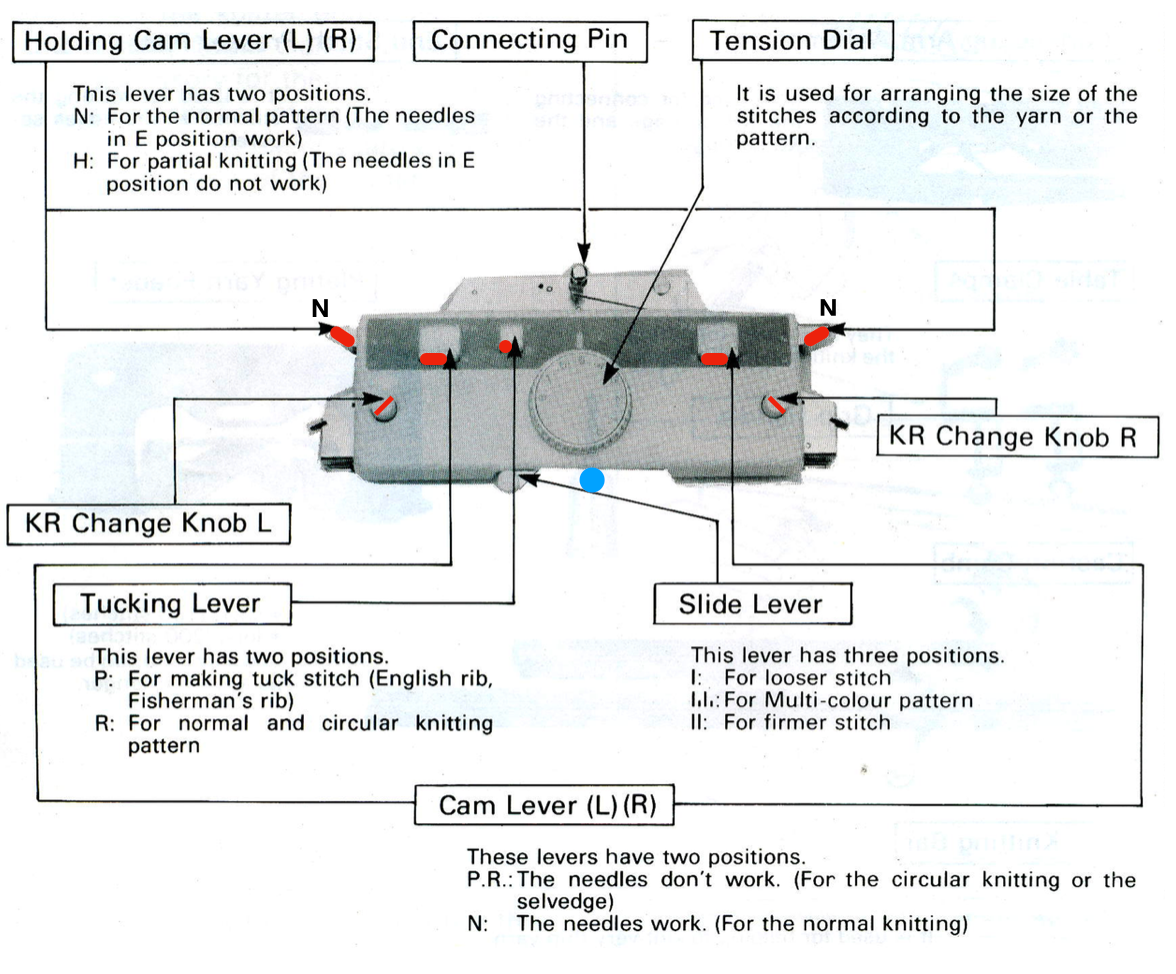 Back in 2015, I wrote on quilting on the machine, using the carriage representation below. Here lili buttons are positioned for use
Back in 2015, I wrote on quilting on the machine, using the carriage representation below. Here lili buttons are positioned for use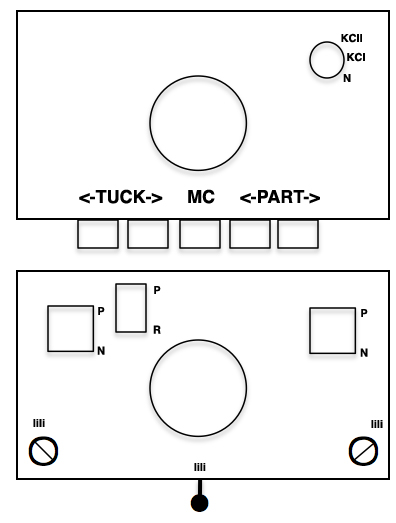
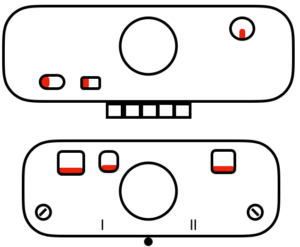
 slip to left
slip to left  slip in both directions
slip in both directions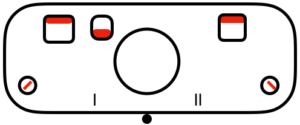
 tuck to right
tuck to right  tuck in both directions
tuck in both directions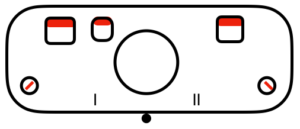

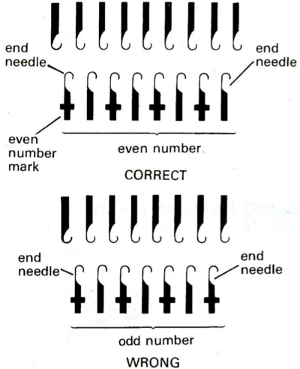
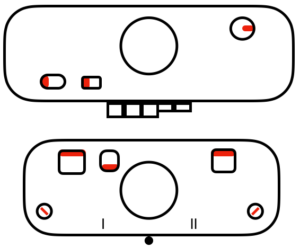
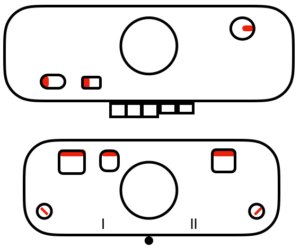

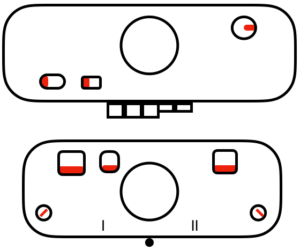
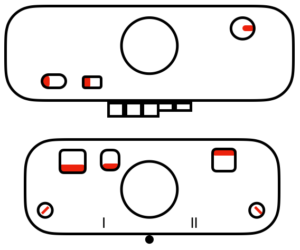 tubular: either pair of opposite part buttons used
tubular: either pair of opposite part buttons used 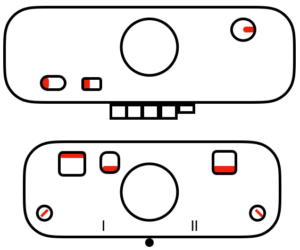
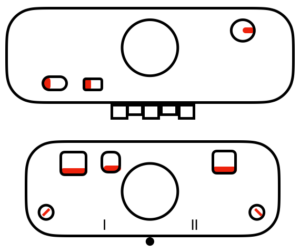 main bed <–> tucked jacquard: each needle on the ribber knits every row. Needles on the main bed knit in pattern according to punched holes, black squares on mylar, or programmed pixels. Non selected needles tuck. The patterns produced on the backside of the fabric are almost the reverse images of the front. Because so many tuck loops are formed the fabric is “short” and very wide, so cast ons and bind offs need to be planned accordingly
main bed <–> tucked jacquard: each needle on the ribber knits every row. Needles on the main bed knit in pattern according to punched holes, black squares on mylar, or programmed pixels. Non selected needles tuck. The patterns produced on the backside of the fabric are almost the reverse images of the front. Because so many tuck loops are formed the fabric is “short” and very wide, so cast ons and bind offs need to be planned accordingly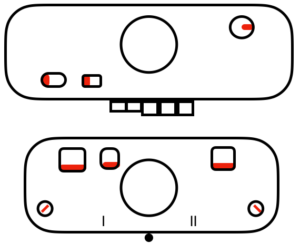 variation: tucking the main color, knitting the contrast, manual cam button reset every 2 rows
variation: tucking the main color, knitting the contrast, manual cam button reset every 2 rows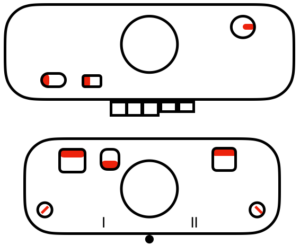

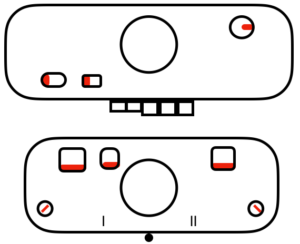

 full fisherman rib: tuck every needle alternately on both beds, in opposite carriage directions (below = L/R, or use R/L)
full fisherman rib: tuck every needle alternately on both beds, in opposite carriage directions (below = L/R, or use R/L)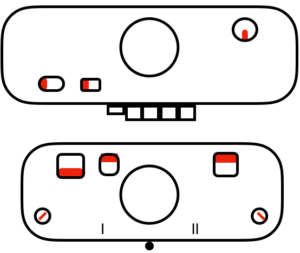
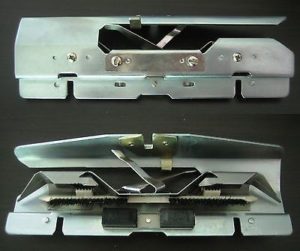

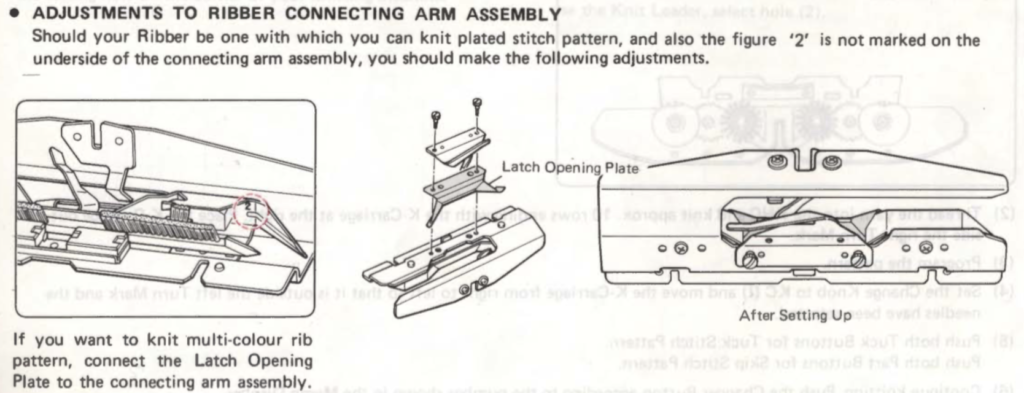
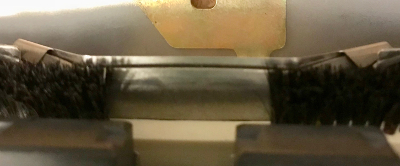

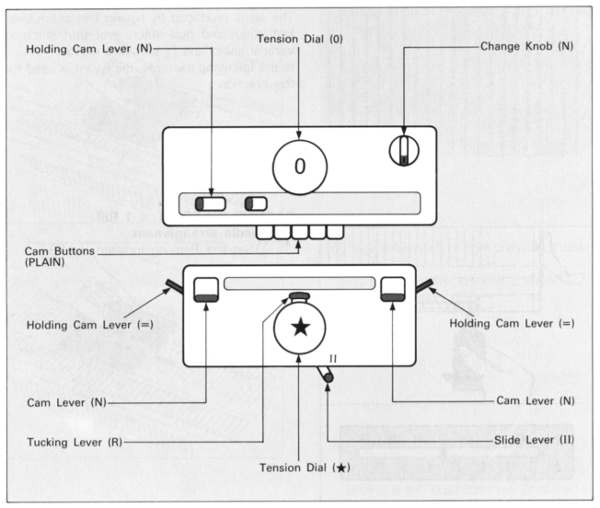





 revised with fewer single dots, and solid lines in the ground
revised with fewer single dots, and solid lines in the ground 
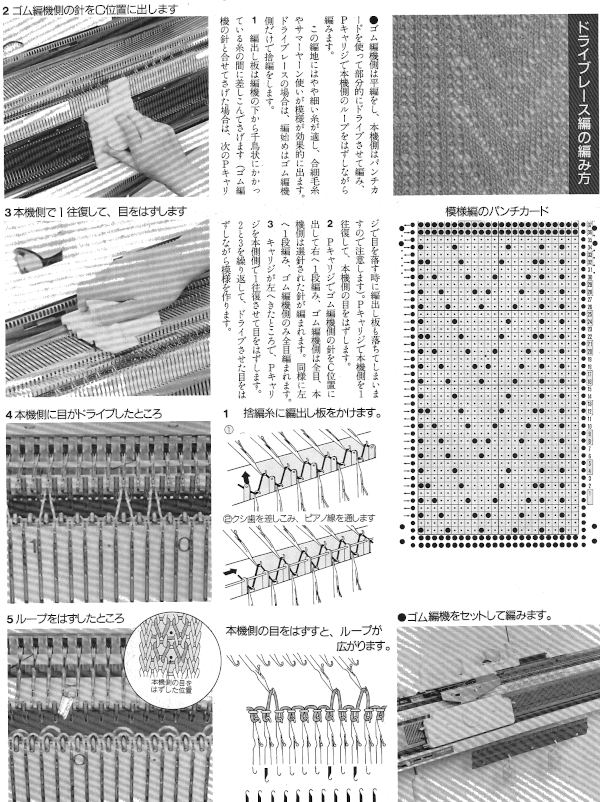
 using any method you prefer, set up knitting so all stitches are on the ribber. If you prefer to set up complete repeats prior to watching, “air knitting” prior to ribber set up or using the position option on the main bed if that is available, will help achieve that
using any method you prefer, set up knitting so all stitches are on the ribber. If you prefer to set up complete repeats prior to watching, “air knitting” prior to ribber set up or using the position option on the main bed if that is available, will help achieve that 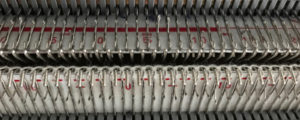 set knit carriage to KC II (used when patterning does not occur on every needle across the needle bed), both part buttons pushed in for free pass to the opposite side of km, no knitting occurs but the first row of pattern knitting is selected. Ribber is set to N<–> throughout
set knit carriage to KC II (used when patterning does not occur on every needle across the needle bed), both part buttons pushed in for free pass to the opposite side of km, no knitting occurs but the first row of pattern knitting is selected. Ribber is set to N<–> throughout the carriages now move to the opposite side, selected needles on the main bed pick up loops, and nonselected needles stay empty. Ribber knits every stitch
the carriages now move to the opposite side, selected needles on the main bed pick up loops, and nonselected needles stay empty. Ribber knits every stitch  using a ribber cast on comb, stitch “dumper”, or another tool, move needles holding stitches forward to drop loops, and return empty needles to work position (B)
using a ribber cast on comb, stitch “dumper”, or another tool, move needles holding stitches forward to drop loops, and return empty needles to work position (B) as carriages move to the opposite side, needles are selected for next row of knit stitches to be knit on main bed
as carriages move to the opposite side, needles are selected for next row of knit stitches to be knit on main bed 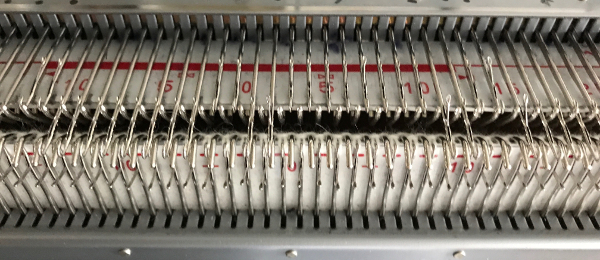 carriages now move to the opposite side, loops are picked up on selected needles
carriages now move to the opposite side, loops are picked up on selected needles 
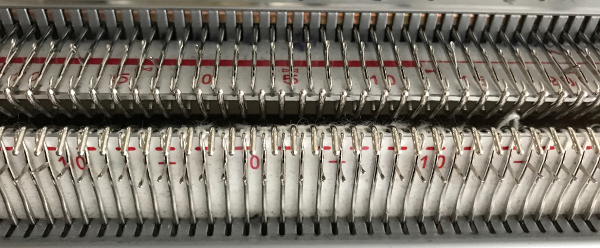
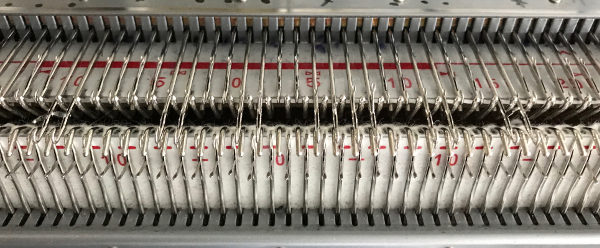 carriages move to the opposite side, picking up loops
carriages move to the opposite side, picking up loops 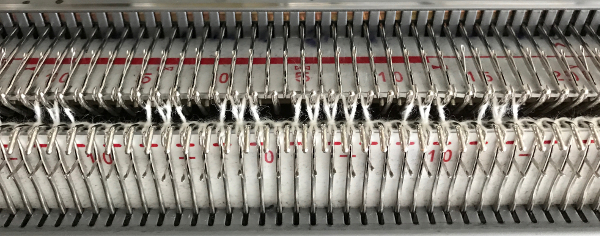 before carriages move again, drop stitches formed. Watch loops after they are dropped, if tugging knitting it is not enough to pull them out of the way of needles returning to patterning, take a tool, or something like a credit card. Slide it from one side to the other between the beds, thus keeping loops clear away from the main bed
before carriages move again, drop stitches formed. Watch loops after they are dropped, if tugging knitting it is not enough to pull them out of the way of needles returning to patterning, take a tool, or something like a credit card. Slide it from one side to the other between the beds, thus keeping loops clear away from the main bed

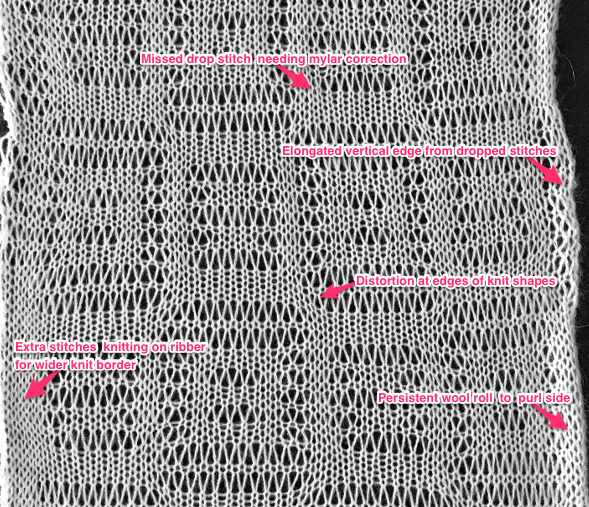

 purl side is shown first for each segment, followed by its knit
purl side is shown first for each segment, followed by its knit
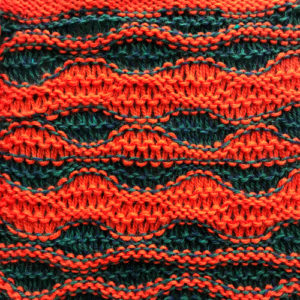
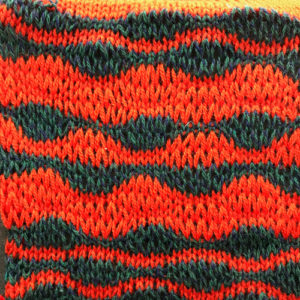


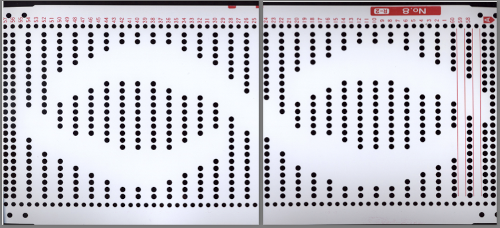
 If using punchcard machines, factory issue punch cards provided with the KM may be used
If using punchcard machines, factory issue punch cards provided with the KM may be used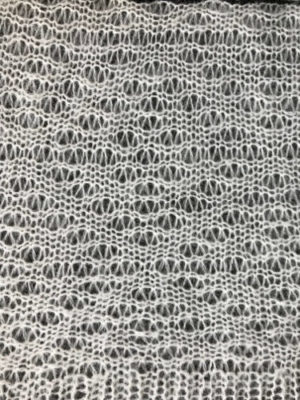

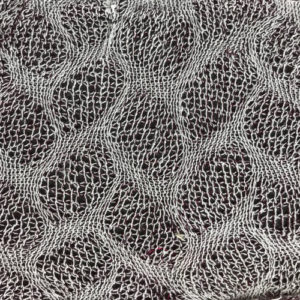 A slip stitch edge may be planned to keep edges of items such as scarves from rolling
A slip stitch edge may be planned to keep edges of items such as scarves from rolling 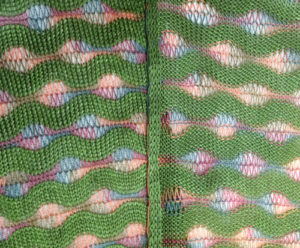 consider top and bottom edgings that include the technique (illustrated in the
consider top and bottom edgings that include the technique (illustrated in the 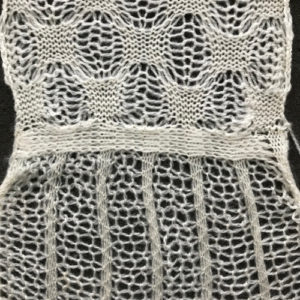

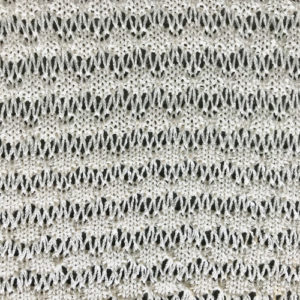 An alternative way to produce this fabric on Brother is to use the knit carriage with no yarn to do the “stitch ditching”. The basic design programmed into any brother machine, electronic or punchcard will need to be altered. The intended design in my sample is a 4 X 4 square, colors represent what would be punched holes, black squares, or pixels. Simple block patterns such as these may be released upon completion of each “square” series, in this case, after 4-row segments.
An alternative way to produce this fabric on Brother is to use the knit carriage with no yarn to do the “stitch ditching”. The basic design programmed into any brother machine, electronic or punchcard will need to be altered. The intended design in my sample is a 4 X 4 square, colors represent what would be punched holes, black squares, or pixels. Simple block patterns such as these may be released upon completion of each “square” series, in this case, after 4-row segments. 
 Rows 5 and 6, 11, and 12 are not part of the original repeat. The 5th design row provides needle selection, traveling from right to left. When the carriage passes in turn from left to right with no yarn, those preselected needles will drop while preselecting a blank design row (6) that allows the carriage to return to the left-hand side. As it moves back to the left, the carriage will preselect the first row of the design. With COL yarn is picked up in order to knit the next set of dropped stitches. A color change may be made while the carriage is on the left.
Rows 5 and 6, 11, and 12 are not part of the original repeat. The 5th design row provides needle selection, traveling from right to left. When the carriage passes in turn from left to right with no yarn, those preselected needles will drop while preselecting a blank design row (6) that allows the carriage to return to the left-hand side. As it moves back to the left, the carriage will preselect the first row of the design. With COL yarn is picked up in order to knit the next set of dropped stitches. A color change may be made while the carriage is on the left.
 More to try: the typical appearance to look for in the source inspiration is that of single-row horizontal geometric designs with all blank rows separating them from each other.
More to try: the typical appearance to look for in the source inspiration is that of single-row horizontal geometric designs with all blank rows separating them from each other.

 The yarn used here was a softly spun rayon that began eventually to split, and get partially caught up on gate pegs, leading to the ending of the swatch
The yarn used here was a softly spun rayon that began eventually to split, and get partially caught up on gate pegs, leading to the ending of the swatch 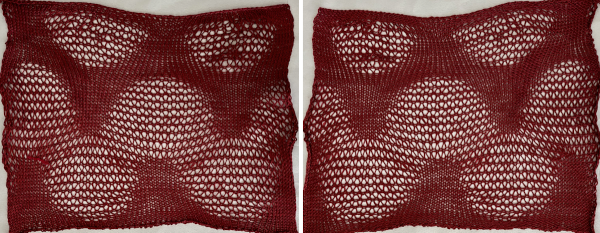
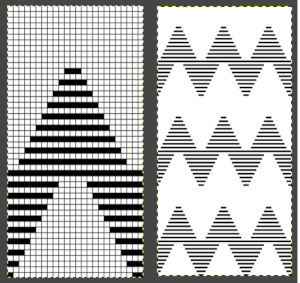
 Fair Isle
Fair Isle
